_______________________________
Video published on Feb 12, 2011 by Paul Lee on YouTube.
“Michigan Citizen” publisher Catherine Kelly and historical features writer Paul Lee discuss the newspaper series commemorating the 40th anniversary of the 1967 Detroit Rebellion on WXYZ-TV/Channel 7’s “Spotlight on the News,” Aug. 12, 2007. (Note by Paul Lee: the actual number of people arrested during the rebellion was 15,000, not 1,700 as he inadvertently says in the Channel 7 interview.)
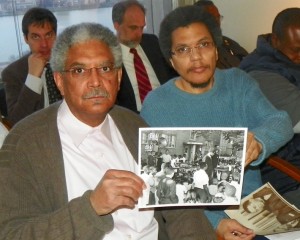
Walter Knall and Paul Lee display photo of Kwame Ture, Jaramogi Abebe Abeygan, and Kenneth Cockrel, Sr. at April 3, 2012 Detroit City Council meeting on “Consent Agreement” that led to state takeover of Detroit, and disastrous contrived bankruptcy. Then Council Pres. Charles Pugh had just forced Lee back to his seat as Lee spoke recalling Detroit’s proud history in the movement for Black self-determination. /Photo by Diane Bukowski
The program includes a rare 1967 interview with the fiery Jaramogi Abebe Agyeman (7:49), then known as the Rev. Albert B. Cleage, Jr., the founder of the Shrines of the Black Madonna of the Pan African Orthodox Christian Church (PAOCC), father of the modern Black theology movement and Detroit’s leading advocate of Black Power or self-determination.
The last installment of the “Citizen” series features a sermon by him and a contemporary journal account by Kristin Cleage Williams, his eldest daughter.
4/22/15 UPDATE: Unfortunately, “The Michigan Citizen” ceased publication in late December 2014. The links to my eight-part “UPRISING!” series are no longer active. However, the texts of Parts 1-7, along with one photo in each part, could be found online as a single pdf here: http://www-personal.umich.edu/~ransom…
Most of Part 8 could be found on Kristin Cleage Williams’s blog here: http://findingeliza.com/archives/18598
To honor the 50th Anniversary of the 1967 Detroit rebellion, VOD is re-publishing this series by the illustrious historian Paul Lee, originally published in the Michigan Citizen on the rebellion’s 40th Anniversary. This version of Parts 1 through 7 of the series is re-constructed from Lee’s PDF document referenced above. Photos collected by Lee were re-photographed from various original issues of the Michigan Citizen retained by VOD. Others have been added by VOD. At the conclusion is a YouTube video by Paul Lee of the entire interview of Jaramogi Abebe Agyeman, part of which is shown in the Channel 7 video above.
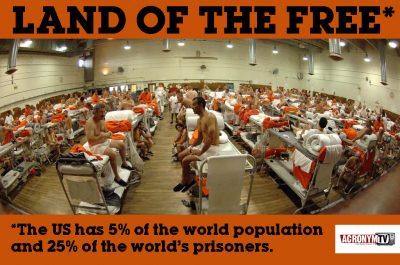
50 YEARS AFTER THE 1967 DETROIT REBELLION
VOD editor Diane Bukowski was an investigative reporter for the Michigan Citizen from 2000 to 2010.
This series is being published as one post due to VOD’s framework. So although the post is lengthy, it is always possible to read some of the eight parts, then come back and finish the others.
Most poignant are Sections 5, 6, and 7 of the series, in which a young Black man arrested during the rebellion recounts his harrowing experiences with a profoundly vicious and racist police state.
Little has changed today, with the mass incarceration of 2.5 million people, mostly those of color, across the U.S. While the U.S. has five percent of the world’s population, it accounts for 25 percent of its incarcerated population. Natural life sentences are common, while most countries don’t have such a sentence. The U.S. was the only country in the world to sentence children to die in prison. Although the U.S. Supreme Court outlawed juvenile life without parole in 2012 and in 2016, at least 300 of Michigan’s juvenile lifers are still serving their unconstitutional terms. Prisoners across the country spend months and even years in solitary confinement, get little if any medical care, and are given food that is not fit for human consumption.
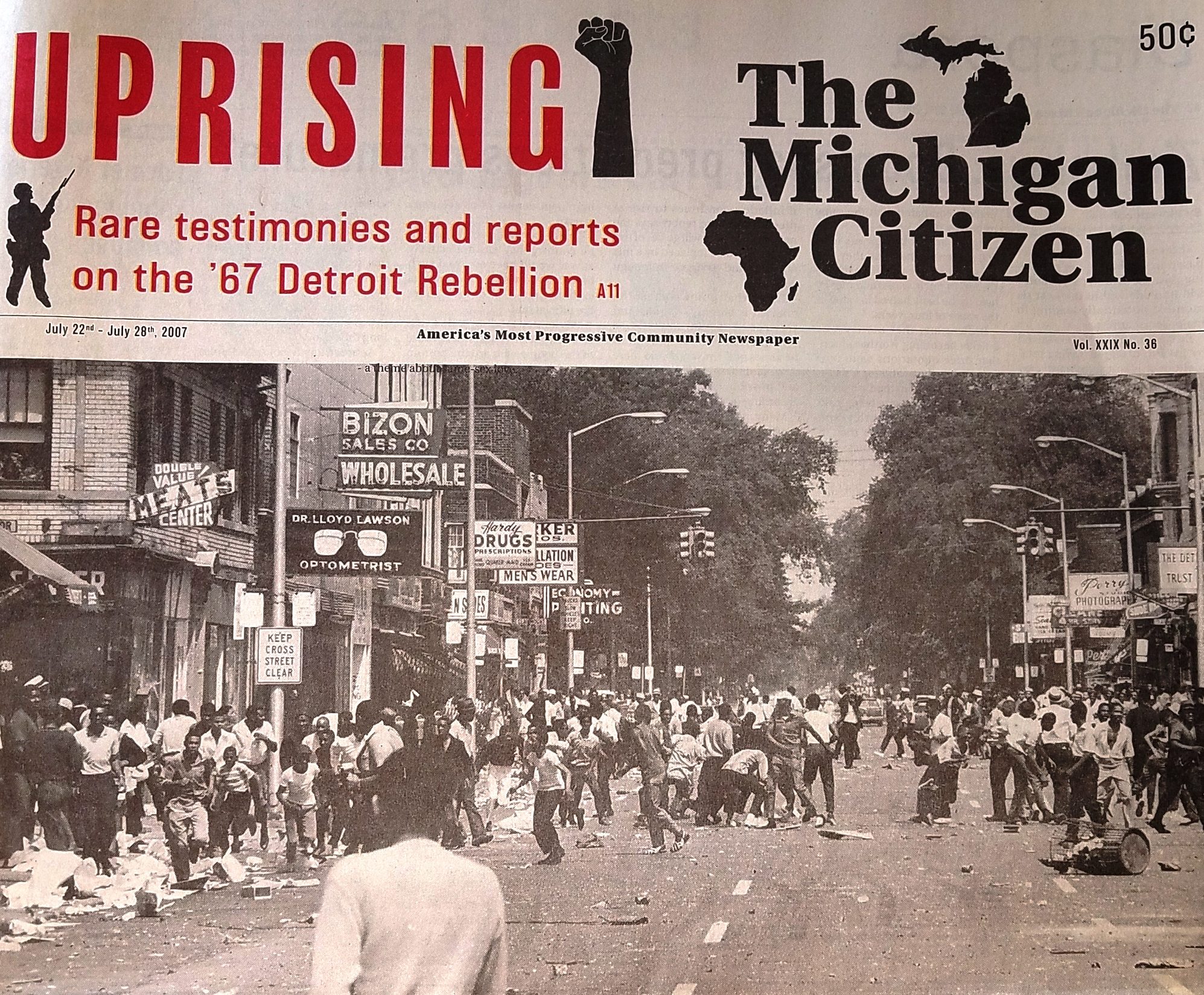
Introduced and edited by Paul Lee
Copyright © 2007 by Paul Lee
PROFILE OF THE REBELLION, PT. 1
[This is] an extended series of rare, never before-published interviews and reports from 1967 and 1968 to commemorate the 40th anniversary of the Detroit Rebellion, which erupted on July 23, 1967.
They are drawn from the voluminous records — most rarely used, some only recently available — of the National Advisory Commission on Civil Disorders, which President Lyndon B. Johnson appointed on July 29, 1967. This 11-member investigative body was popularly called the Kerner Commission after its chairman, Illinois Governor Otto Kerner, Jr.
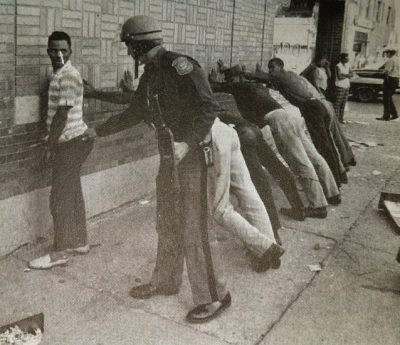
RESENTMENT: A Michigan State Trooper searches a youth on 12th Street July 24, 1967 as his companions await their turn.
It was created when the flames of the most destructive and costly urban uprising in U. S. history — surpassed only by the 1992 disorders in Los Angeles — were dying down and popular resentment over the armed and deadly occupation by the police, National Guard and U. S. Army, coupled with the abuse of thousands of innocent Detroiters by the prosecutor and courts, was heating up.
These events would forever change the social, economic and political landscape of Detroit.
President Johnson promised the commissioners that they would “be free” to follow the truth wherever it led and charged them to answer three questions: “What happened? Why did it happen? What can be done to prevent it from happening again and again?”
Below we begin publishing the original text of the commission’s generally fair answer to the first two questions, which later appeared in the “Report of the National Advisory Commission on Civil Disorders” (Washington, D. C.: Government Printing Office, March 1, 1968, also published by Bantam Books). The only changes we have made are to add subheadings and silently correct obvious misspellings. Historical corrections or additions are enclosed in [square braces].
 Ironically, as we shall see in future installments, the president refused to accept, or even consider, the conclusions and recommendations of his commission, which held that the “most fundamental” cause of the urban disorders that were engulfing the nation in annual “long, hot summers” was the “racial attitude and behavior of white Americans toward Black Americans,” or Negroes, as they were also called.
Ironically, as we shall see in future installments, the president refused to accept, or even consider, the conclusions and recommendations of his commission, which held that the “most fundamental” cause of the urban disorders that were engulfing the nation in annual “long, hot summers” was the “racial attitude and behavior of white Americans toward Black Americans,” or Negroes, as they were also called.
This profile of the Detroit uprising will be followed by often vivid, detailed interviews with a remarkably diverse cross-section of local officials, observers and participants, as well as reports by the commission’s mostly keen field investigators. We urge you to share this series with your family, friends, co-workers and acquaintances.
The Kerner Report: PROFILES OF DISORDER
VII. DETROIT
On Saturday evening, July 22, the Detroit Police Department raided five blind pigs. The blind pigs had their origin in the days before World War II, when they had served as private social clubs for affluent Negroes who, because of discrimination, had been unable to gain entrance to public night spots. Gradually, as public facilities opened their doors to Negroes, the character of the blind pigs had changed, and they had become illegal drinking and gambling spots.
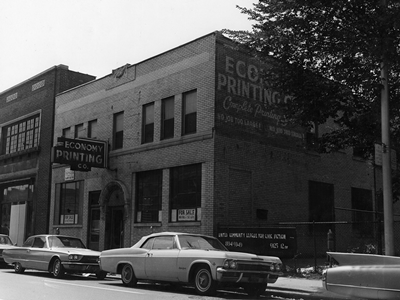
United Community and Civic League HQ, 12th and Clairmount, site of “blind pig.” Detroit Free Press photo
The fifth blind pig on the list, the United Community and Civic League at the corner of 12th Street and Clairmount, had been raided twice before. Once 10 persons had been picked up; another time, 28.
A Detroit Vice Squad officer had tried but had been unable to gain entrance to the blind pig shortly after ten o’clock Saturday night. When, on his second attempt, he was successful, it was 3:45 A.M. Sunday morning.
The Tactical Mobile Unit, the Police Department’s Crowd Control Squad, had been dismissed at 3:00 A.M. Since Sunday morning is, traditionally, the least troublesome time for police departments all over the United States, there were only 193 officers patrolling the streets. Of these, 44 were in the 10th Precinct where the blind pig was located.
Instead of the expected two dozen patrons, the blind pig — in which a party for several servicemen, two of whom had been stationed in Vietnam, was being held — contained 82. Some expressed resentment at the police intrusion. Before additional patrol wagons could be called to transport all the persons from the scene, an hour had elapsed. The weather was warm — during that day the temperature was to rise to 86 degrees — and humid.
Despite the hour, numerous persons were still on the streets. Within a short period a crowd of approximately 200 persons had gathered.
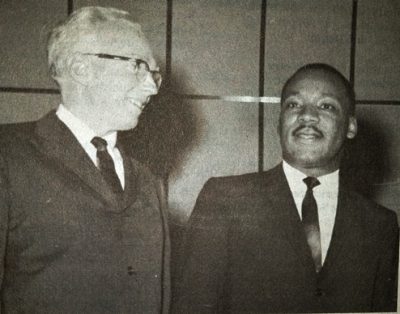
Detroit Police Commissioner George Edwards with Dr. Martin Luther King, Jr., after historic “Walk to Freedom” march, Cobo Arena, June 23, 1963. DETROIT NEWS PHOTO/WALTER P. REUTHER LIBRARY, WSU
THE LEADING CANDIDATE
The leading candidate In November of 1965, George Edwards, Judge of the United States Court of Appeals for the Sixth Circuit, and Commissioner of the Detroit Police Department from 1961 to 1963, had written in the Michigan Law Review: “It is clear that in 1965 no one will make excuses for any city’s inability to foresee the possibility of racial trouble… Although local police forces generally regard themselves as public servants with the responsibility of maintaining law and order, they tend to minimize this attitude when they are patrolling areas that are heavily populated with Negro citizens. There they tend to view each person on the streets as a potential criminal or enemy, and all too often that attitude is reciprocated. Indeed, hostility between the Negro communities in our large cities and the police departments, is the major problem in law enforcement in this decade. It has been a major cause of all recent race riots.”
At the time of the 1943 riot, Judge Edwards told Commission investigators, there was “open warfare between the Detroit Negroes and the Detroit Police Department.” As late as 1961, he thought that “Detroit was the leading candidate in the United States for a race riot.”
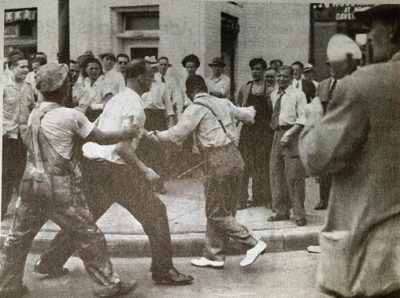
A photographer (r) captures a white mob assaulting an African-American man during the Detroit “race riot” June 22, 1943. Bettman/Corbis photo
There was a long history of conflict between the police department and citizens. Detroit’s 1943 race riot, in which 34 persons died, was the bloodiest in the United States in a span of four decades. During the labor wars of the 1930’s union members had come to view the Detroit Police Department as a strike-breaking force.
Judge Edwards and his successor, Commissioner Ray Girardin, attempted to restructure the image of the department. A Citizens Complaint Bureau was set up to facilitate the filing of complaints by citizens against officers. Indications are, however, that in practice it worked little better than less enlightened and more cumbersome procedures in other cities.
SPARKS
On 12th Street, with its high incidence of vice and crime, the issue of police brutality was a recurrent theme. A month earlier the killing of a prostitute had been determined by police investigators to be the work of a pimp. According to rumors in the community the crime had been committed by a Vice Squad officer.

Approximately at the same time the killing of a 27-year old Negro Army veteran, Danny Thomas, by a gang of white youths, had inflamed the community. Coverage by the city’s major newspapers, which played down the story in hope that the murder would not become a cause for increased tensions, backfired. A sensationalized banner story in the Michigan Chronicle, the city’s Negro newspaper, began: “As James Meredith marched again Sunday to prove a Negro could walk in Mississippi without fear, a young woman who saw her husband killed by a white gang, shouting: ‘Niggers keep out of Rouge Park,’ lost her baby. “Relatives were upset that the full story of the murder was not being told, apparently in an effort to prevent the incident from sparking a riot.”
Some Negroes believed that the treatment of the story by the major newspapers was further evidence of the double standard: Playing up crimes by Negroes, playing down crimes committed against Negroes.
Although police arrested and charged one suspect with murder, Negroes questioned why the entire gang was not held. What, they asked, would have been the result if a white man had been killed by a gang of Negroes? What if Negroes had made the kind of advances toward a white woman that the white men were rumored to have made toward Mrs. Thomas? The Thomas family had lived only four or five blocks from the scene of the blind pig raid.
A few minutes after 5:00 A.M., shortly after the last of those arrested had been hauled away, a police cruiser had its rear window smashed by an empty bottle. Shortly thereafter a litter basket was thrown through the window of a store. Rumors of excess force used by the police during the raid were circulated. A youth, whom police nicknamed “Mr. Greensleeves” because of the green shirt he was wearing, was shouting: “We’re going to have a riot!” and exhorting the crowd to vandalism.
12th STREET
At 5:20 A.M. Commissioner Ray Girardin was notified. He immediately called Mayor Jerome Cavanagh. Seventeen officers from other areas were ordered into the 10th Precinct. By 6:00 A.M. police department strength had grown to 369 men. Of these, however, only 43 were committed to the immediate riot area. By that time the number of persons on 12th Street was growing into the thousands, and widespread window-smashing and looting had begun.
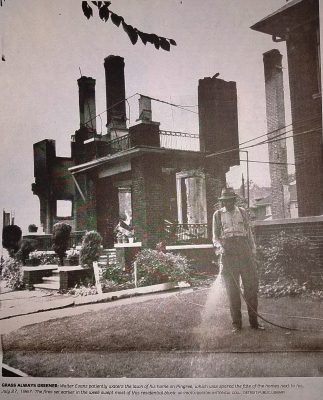
Homeowner from nearby middle class area waters lawn after adjacent houses burned down during rebellion.
Although a block to either side of 12th Street were fine middle class districts, along 12th Street itself overcrowded apartment houses created a density of more than 21,000 persons per square mile, almost double the city average. Only 18 percent of the residents were homeowners. Twenty-five percent of the housing was considered so substandard as to require clearance, and another 19 percent had major deficiencies. The crime rate was almost double that of the city as a whole. A Detroit police officer told Commission investigators that prostitution was so widespread that officers arrested prostitutes only when their soliciting became blatant.
The proportion of broken families was more than twice that in the rest of the city. The movement of people when the slums of “Black Bottom” had been cleared for urban renewal had changed 12th Street from an integrated community into an almost totally Black one, in which only a number of the merchants remained white.
TOO LITTLE, TOO LATE
By 7:50 A.M., when a 17-man police commando unit attempted to make the first sweep, there were an estimated 3,000 persons on 12th Street. They offered no resistance. As the squad moved down the street, they gave way to one side, and then flowed back behind it. The manager of a shoe store had watched for two hours as the store was being looted, vainly awaiting, according to him, the arrival of the police. At 8:25 A.M. someone in the crowd yelled “The cops are coming!” and flames blossomed from the interior of the store. It was the first fire of the riot. Firemen who responded were not harassed. The flames were extinguished.
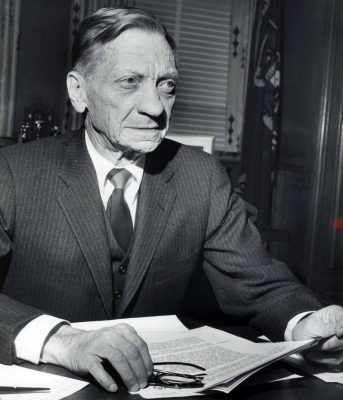
Ray Girardin, Detroit Police Commissioner 1963-68.
By mid-morning 1,122 men, approximately a fourth of the strength of the police department, had reported for duty. Of these, 540 were in the riot area, which still had not expanded beyond six blocks. One hundred and eight officers were being used in an attempt to establish a cordon. There was, however, no interference with looters, and police were refraining from the use of force.
According to witnesses, police at some roadblocks made little effort to stop people from going in and out of the area. A good deal of bantering took place between police officers and the populace, some of whom were still dressed in their pajamas. There seemed, to some observers, at this point to be an atmosphere of apathy: the police did not appear to care what was happening, and many of the older and more stable residents, who had seen the street deteriorate from a prosperous commercial thoroughfare to one ridden by vice, remained aloof.
Commissioner Girardin believed: “If we had started shooting in there … not one of our policemen would have come out alive. I am convinced it would have turned into a race riot in the conventional sense.”
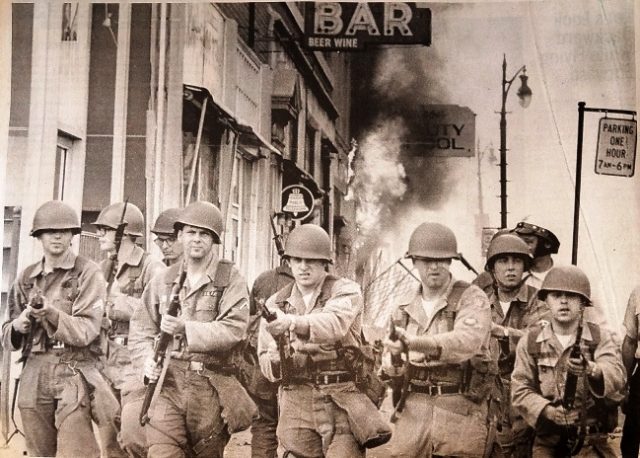
THE WAR AT HOME: Michigan National Guardsmen with fixed bayonets clear the front of a burning building on the first day of the Rebellion, July 23, 1967. UPI Photo Burton Historical Collection Detroit Public Library
PROFILE OF THE REBELLION, Pt. 2
Introduced and edited by Paul Lee
This week, The Michigan Citizen continues publishing the text of “Profiles of Disorder,” the generally balanced account of the July 23-27, 1967, Detroit Rebellion, prepared by the National Advisory on Civil Disorders, or Kerner Commission.
President Lyndon B. Johnson appointed the 11-member commission on the last day of the rebellion to determine the causes of the explosive, mostly urban “disorders”— the commission counted 164 in the first nine months of 1967 — and make recommendations to prevent their repetition.
It was chaired by Illinois Gov. Otto Kerner, Jr., and included liberal Republican New York City Mayor John V. Lindsay (vice chair), NAACP executive secretary Roy Wilkins and Massachusetts Sen. Edward W. Brooke, an African American Republican.
The Detroit profile was later published, in slightly different form, in the “Report of The National Advisory Commission on Civil Disorders” (Washington, D. C.: Government Printing Office, March 1, 1968, also published by Bantam Books). The original text is from the commission’s records in the Johnson Library and Museum in Austin, Tex.
A special effort has been made to provide precise locations for all aerial and street photos and highlight local institutions that helped define the unique character of each neighborhood. The only changes we have made are to add subheadings and silently correct obvious misspellings. Historical corrections or additions are enclosed in [square brackets].
The Kerner Report (cont’d.)
THE KERCHEVAL INCIDENT
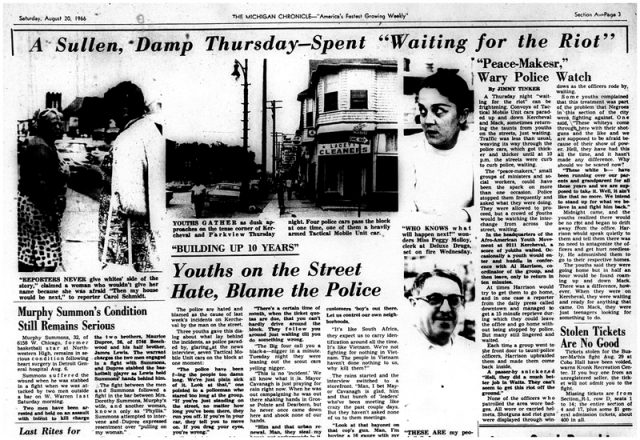
The Michigan Chronicle reports on the 1966 “Kercheval incident”: YOUTHS ON THE STREET HATE, BLAME THE POLICE
Many of the police officers were being used to guard key installations in other sections of the city, on the basis that the disturbance on 12th Street might be a diversionary tactic. Belle Isle, the recreation area in the Detroit River that had been the scene of the 1943 riot, was sealed off.
In an effort to avoid attracting people to the scene, some broadcasters cooperated by not reporting news of the riot, and an effort was made to downplay the extent of the disorder. The facade of “business as usual” necessitated the detailing of numerous police officers to protect the 50,000 spectators that were expected at that afternoon’s New York Yankees-Detroit Tigers baseball game.
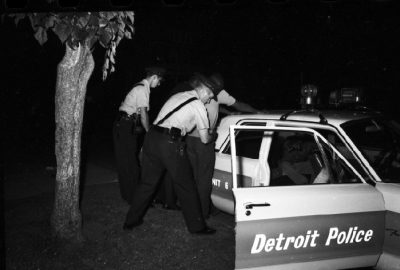
Detroit Police Tactical Mobile Unit on Belle Isle in 1965, dispatched to quiet an alleged “near-riot.”
Early in the morning a task force of community workers had gone into the area to dispel rumors and act as counter-rioters. Such a task force had been singularly successful at the time of the incident in the Kercheval district in the Summer of 1966, when scores of people had gathered at the site of an arrest. Kercheval, however, had a more stable population, fewer stores, less population density, and the city’s most effective police-community relations program.
VOD: Note contradictory headlines in Michigan Chronicle story above. There was additionally a rebellion on Belle Isle in 1965, which was brutally put down by Detroit Police.
PERCENTAGES OF DISCONTENT
The 12th Street area, to the contrary, had been determined in a 1966 survey conducted by Dr. Ernest Harburg of the Psychology Department of the University of Michigan to be a community of high stress and tension.
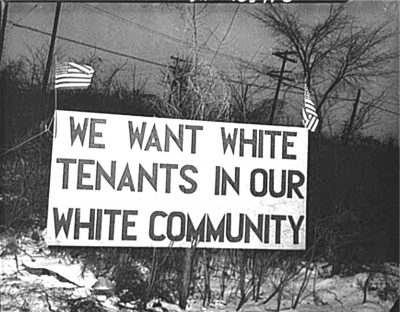
Vicious housing discrimination and attacks including KKK neighborhood flag-burnings, characterized white Detroit in 1967.
An overwhelming majority of the residents indicated dissatisfaction with their environment. Of those interviewed, 93 percent said they wanted to move out of the neighborhood; 73 percent felt that the streets were not safe; 91 percent believed that a person was likely to be robbed or beaten at night; 58 percent knew of a fight within the last 12 months in which a weapon had been employed; 32 percent stated that they themselves owned a weapon; 57 percent were worried about fires.
A significant proportion believed municipal services to be inferior; 36 percent were dissatisfied with the schools; 43 percent with the city’s contribution to the neighborhood; 77 percent with the recreational facilities; 78 percent believed police did not respond promptly when they were summoned for help.
APPEAL
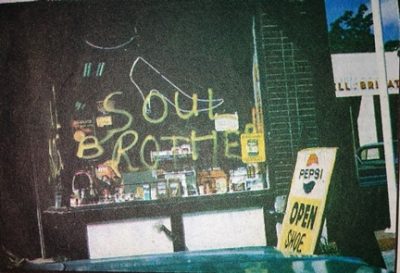
SOUL! Shoe store with “SOUL BROTHER” spray-painted on its window in hopes of protecting it from being vandalized. BURTON HISTORICAL COLLECTION
U.S. Representative John Conyers, Jr., a Negro, was notified about the disturbance at his home, a few blocks from 12th Street, at 8:30 A.M. Together with other community leaders, including Hubert G. Locke, a Negro Assistant Commissioner of Police, he began to drive around the area. In the side streets he asked people to stay in their homes. On 12th Street, he requested them to disperse. It was, by his own account, a futile task.
Numerous eyewitnesses interviewed by Commission investigators tell of the carefree mood with which people ran in and out of stores, looting and laughing, and joking with the police officers. Stores with “Soul Brother” signs appeared no more immune than others. Looters paid no attention to residents who shouted at them and called their actions senseless. An epidemic of excitement had swept over the persons on the street. Representative Conyers noticed a woman with a baby in her arms; she was raging, cursing “whitey” for no apparent reason except that in this atmosphere her anger of many years was able to find release.
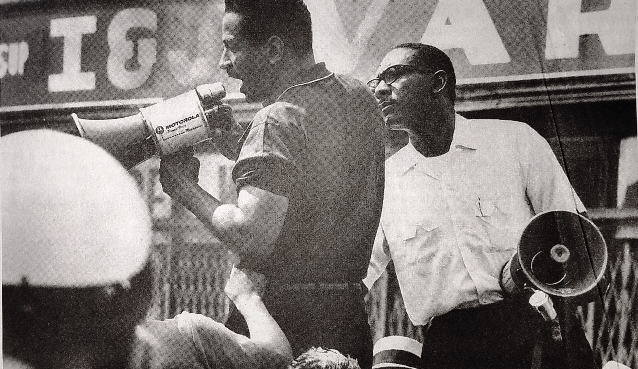
VAIN CALL: U.S. Rep. John Conyers (speaking into bullhorn) and NAACP official Arthur Johnson vainly appeal for calm as the rebellion builds toward and explosion on the west side of 12th Street near Virginia Park, July 23, 1967. “John, let’s get the hell out of here,” Johnson later recalled advising Conyers. DETROIT NEWS PHOTO
Shortly before noon Representative Conyers climbed to the top of a car in the middle of 12th Street to address the people. As he began to speak he was confronted by a man in his fifties whom he had once, as a lawyer, represented in court. The man had been active in civil rights. He believed himself to have been persecuted as a result, and it was Conyers’ opinion that he may have been wrongfully jailed. Extremely bitter, the man was inciting the crowd and challenging Conyers: “Why are you defending the cops and the establishment? You’re just as bad as they are!”
A police officer who was at the scene told Commission investigators that neither he nor his fellow officers received any instructions as to what they were supposed to be doing. Witnesses tell of officers standing behind saw-horses as an area was being looted, and still standing there a considerable period later, when the mob had moved elsewhere. A squad from the commando unit, wearing helmets to which face-covering visors were attached, and carrying carbines topped with bayonets, blockaded a street several blocks from the scene of the riot. Their appearance drew residents into the street. Some began to harangue them and to question why they were in an area where there was no trouble. Representative Conyers convinced the police department to remove the commandos.
RUMOR
By that time a rumor was threading its way through the crowd that a man had been bayoneted by the police. Influenced by such stories, the mood of the crowd became belligerent.
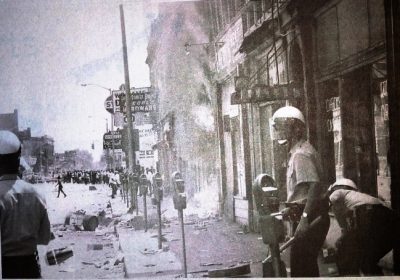
Detroit policemen wearing helmets, plastic visors and carrying batons, face an enraged crowd and a raging fire (r) on 12th Street below Philadelphia several hours after the rebellion began. They appear to be picking up musical instruments from a looted store. Economist Karl D. Gregory, who observed the police, later told a Kerner Commission investigator that they stood “with rifles and fixed bayonets. . .shoulder to shoulder. . .looking at us as is they dared the crowd to move toward them . . .challenging the manhood of people. . .” DETROIT PHOTO ARCHIVES
At approximately 1:00 P.M. stonings of police officers accelerated. Numerous officers reported injuries from rocks, bottles, and other objects thrown at them. Smoke billowed upward from four fires, the first since the one at the shoe store, early in the morning. When firemen answered the alarms, they became the target for rocks and bottles.
At 2:00 P.M. Mayor [Jerome P.] Cavanagh met with community and political leaders at police headquarters. Until that time there had been hope that, as the people blew off steam, the riot would begin to dissipate itself.
Now the opinion was nearly unanimous that additional forces would be needed. A request was made for State Police aid. By 3:00 P.M. 360 officers were assembling at the armory. At that very moment looting was spreading from the 12th Street area to other main thoroughfares.
White flight, flunking schools and closed unions
There was no lack of the disaffected to help spread it. Although not yet as hard-pressed as Newark, Detroit, like Newark, was losing population. Its prosperous middle class whites were moving to the suburbs and being replaced by unskilled Negro migrants.
Between 1960 and 1967 the Negro population rose from just under 30 percent to an estimated 40 percent of the total. Those who moved out were the more vigorous, revenue-producing portion of the population, leaving behind numbers of the old and young, who were less productive, yet cost the city more in terms of services.
In a decade the school system had gained 50,000 to 60,000 children. Fifty-one percent of the elementary school classes were overcrowded. Simply to achieve the statewide average, the system needed 1,650 more teachers, which would mean the building of an additional 1,000 classrooms. The combined cost would be $63 million. Of 300,000 school children, 171,000, or 57 percent, were Negro. According to the Detroit Superintendent of Schools, 25 different school districts surrounding the city spent up to $500 more per pupil per year than Detroit. In the inner city schools more than half the pupils who entered high school became dropouts.
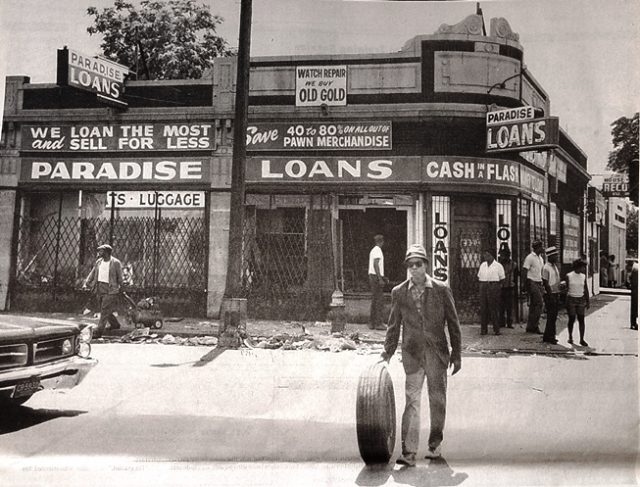
PARADISE LOST: A young man walks with might be a trophy past the looted Paradise Loans in Detroit’s North End, Oakland and Owen, July 25, 1967. At right is the famous Elma’s House of Records. L. Whigham PHOTO BURTON HISTORICAL COLLECTION, DETROIT PUBLIC LIBRARY
The strong union structure had created excellent conditions for most working men, but had left others, such as Civil Service and Government workers, comparatively disadvantaged and dissatisfied. In June the “Blue Flu” had struck the city as police officers, forbidden to strike, had staged a sick-out. In September, the teachers were to go on strike. The starting wages for a plumber’s helper were almost equal to the salary of a police officer or teacher.
Some unions, traditionally closed to Negroes, zealously guarded training opportunities. In January of 1967 the school system notified six apprenticeship trades it would not open any new apprenticeship classes unless a larger number of Negroes were included. By the Fall of 1967 some of the programs were still closed.
ECONOMIC DIVIDE
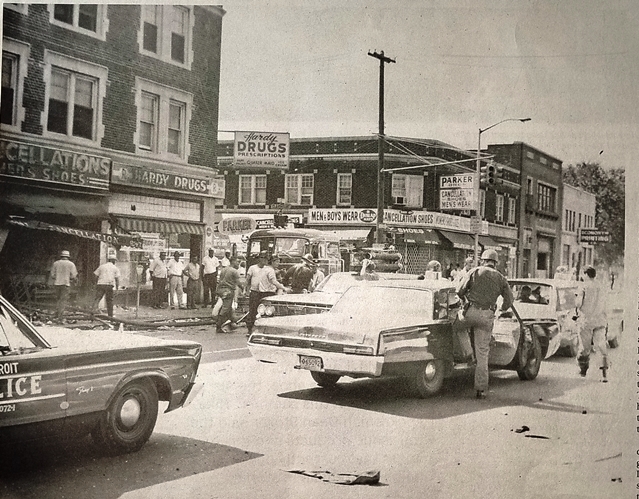
GROUND ZERO: Detroit police, Michigan State police and Detroit firemen converge on 12th St. at Clairmount on July 25, 1967, the third day of the Rebellion. The “blind pig,” or after-hours club, where the uprising began is on the second floor of the Economy Printing Building at right. L. WHIGHAM PHOTO: BURTON HISTORICAL COLL. DETROIT PUBLIC LIBRARY
High school diplomas from inner city schools were regarded by personnel directors as less than valid. In July of 1967 unemployment was higher than it had been for five years. In the 12th Street area it was estimated to be between 12 and 15 percent for Negro men; 30 percent or higher for those under 25.
(See account of 1966 rebellion by Northern High School students being railroaded into non-college studies at http://www.freep.com/story/news/local/michigan/detroit/2017/07/17/detroit-67-1966-student-walkout-northern-sign-things-come/483019001/.)
The more education a Negro had, the greater was the disparity between his income and that of a white with the same level of education. Whereas the income of whites and Negroes with a 7th grade education was about equal, the median income of whites with a high school diploma was $1,600 more per year than that of Negroes, and white college graduates made $2,600 more per year than their Negro counterparts. In fact, so far as his income was concerned, it made very little difference to a Negro whether he had attended school for 8 years or for 12. In the fall of 1967, a study conducted at one inner city high school, Northwestern, showed that, although 50 percent of the dropouts had found work, 90 percent of the 1967 graduating class was unemployed.
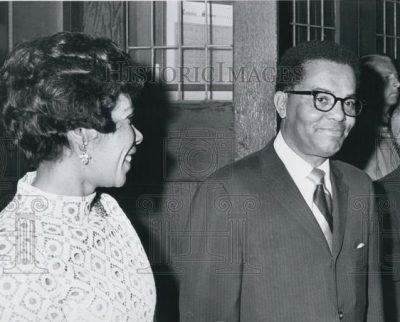
Rev. and Mrs. Nicholas Hood, Sr. He was the only Black city councilman in 1967.
Although Mayor Cavanagh had appointed many Negroes to key positions in his administration, in elective offices the Negro population was still under-represented. Of nine councilmen, one was a Negro [Nicholas Hood Sr]. Of seven members of the school board, two were Negroes [Dr. Remus G. Robinson and the Rev. Darneau V. Stewart].
Although Federal programs had brought nearly $360 million to the city between 1962 and 1967, the money appeared to have had little impact at the grass-roots level. Urban renewal programs, for which $38 million had been allocated, were opposed by many residents of the poverty area.
Because of the financial straits in which it found itself, the city was unable to produce on promises to correct conditions — such as poor garbage collection or bad street lighting — which brought constant complaints from Negro residents.
‘DANCING AMIDST THE FLAMES’
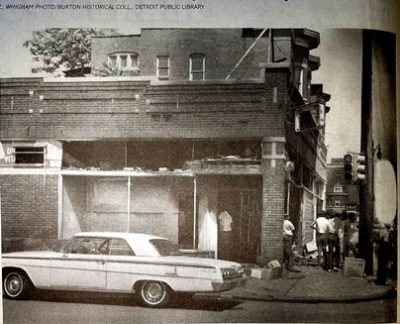
This drugstore at the corner of E. Canfield and Chene was looted and set afire as well, as the Rebellion spread to the east side.
On 12th Street Carl Perry, the Negro proprietor of a drug store and photography studio, was passing out ice cream, sodas, and candy to the youngsters streaming in and out of his store. For safekeeping he had brought the photography equipment from his studio, in the next block, to the drugstore. The youths milling about repeatedly reassured him that, although the market next door had been ransacked, his place of business was in no danger.
In mid-afternoon the market was set afire. Shortly thereafter the drugstore went up in flames.
State Representative James Del Rio, a Negro, was standing in front of a building owned by him when two small boys, neither more than 10 years old, approached. As one of the boys prepared to throw a brick through a window Del Rio stopped him: “That building belongs to me,” he said. “I’m glad you told me, Baby, because I was just about to bust you in!” the youngster replied.

State Rep. James DelRio in 1965.
Some evidence that criminal elements spontaneously were organizing to take advantage of the riot began to manifest itself. A number of cars were noted to be re-turning again and again, their occupants methodically looting stores. Months later goods stolen during the riot were still being sold.
A spirit of carefree nihilism was taking hold. To riot and to destroy appeared more and more to become ends in themselves. Late Sunday afternoon it appeared to one observer that the young people were “dancing amidst the flames.”
A Negro plainclothes officer was standing at an intersection when a man threw a Molotov cocktail into a business establishment at the corner. In the heat of the afternoon, fanned by a 20 to 25 m.p.h. wind that blew both on Sunday and Monday, the fire was, within minutes, licking at the residential structure next door. As residents made futile attempts to contain the flames with garden hoses, the fire jumped from roof to roof of the two and three-story buildings. Within the hour the entire block was aflame. The ninth house in the row was that of the firebug who had thrown the Molotov cocktail.
FIREFIGHTERS UNDER FIRE
In some areas residents organized rifle squads to protect firefighters. Elsewhere the firemen were subjected to curses, rock-throwing and, as the fires spread to residential streets, to growing hostility.
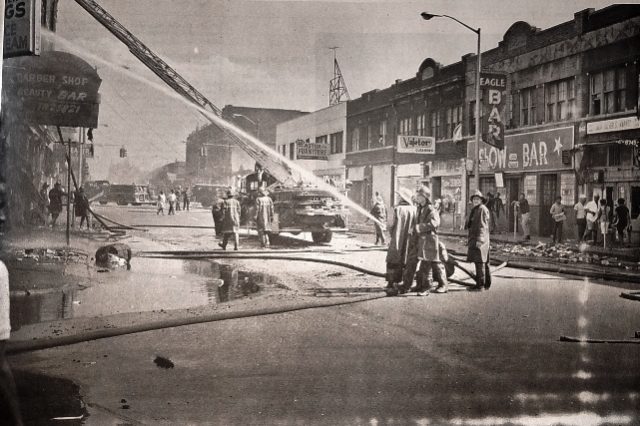
ON GUARD: Firefighters hose down a building on 12th Street near Euclid July 25, 1967, the third day of the rebellion. At right is the Eagle Show Bard, which featured local blues musicians, including Washboard Willie and His Super Suds of Rhythm, recalls former area resident Karamo (Ronald) Hewitt. L. Whigham Photo/BURTON HISTORICAL COLLECTION DETROIT PUBLIC LIBRARY
As the wind-whipped flames blossomed and leapfrogged everywhere, the Detroit Fire Department began to be overwhelmed. Because of a lack of funds, on a per capita basis the department is one of the smallest in the nation. In comparison to Newark, where approximately 1,000 firemen patrol an area of 16 square miles with a population of 400,000, Detroit’s 1,700 firemen are forced to cover a city of 140 square miles with a population of l.6 million. Because the department had no mutual aid agreement with surrounding communities, it could not quickly call in reinforcement from outlying areas, and, it was almost 9:00 that evening before the first began to arrive.
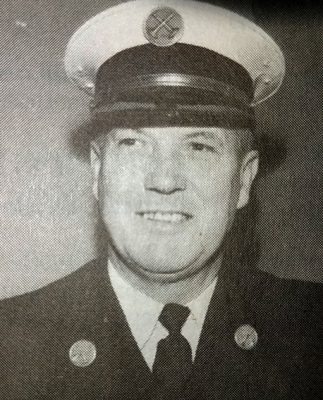
Detroit Fire Chief Charles Quinlan
As the afternoon progressed the Fire Department’s radio pulsated with messages of apprehension and orders to take no chances: “There is no police protection here at all; there isn’t a policeman in the area… If you have any trouble at all, pull out!… We’re being stoned at the scene… It’s [the fire] going good. We need help!… Protect yourselves! Proceed away from the scene… Engine 42 over at Linwood and Gladstone. They are throwing bottles at us so we’re getting out of the area… All companies without police protection — all companies without police protection — orders are to withdraw, do not try to put out the fires. I repeat — all companies without police protection orders are to withdraw, do not try to put out the fires!”
It was 4:30 P.M. when the firemen, some of them exhausted by the heat, abandoned an area of approximately 100 square blocks on either side of 12th Street to await protection from police and National Guardsmen. During the course of the riot firemen were to withdraw 283 times, and Fire Chief Charles J. Quinlan estimated that at least two-thirds of the buildings destroyed were due to spreading fires rather than ones set at the scene. Of the 683 structures involved, approximately one-third were residential, and in few if any of these was a fire originally set.
Governor George Romney flew over the area between 8:30 and 9:00 o’clock that evening. “It looked like the city had been bombed on the west side and there was an area two-and-a-half miles by three-and-a-half miles with major fires, with entire blocks in flames,” he told the Commission.
INDIVIDUAL RESPONSES
In the midst of chaos, individual responses sometimes were unexpected.
Twenty-four year old E. G., a Negro born in Savannah, Georgia, had arrived in Detroit in 1965 in order to attend Wayne State University. Rebellion had been building in him for a long time because “You just had to bow down to the white man… When the insurance man would come by he would always call out to my mother by her first name and we were expected to smile and greet him happily… Man, I know he would never have thought of me or my father going to his house and calling his wife by her first name. Then I once saw a white man slapping a young pregnant Negro woman on the street with such force that she just spun around and fell. I’ll never forget that.”
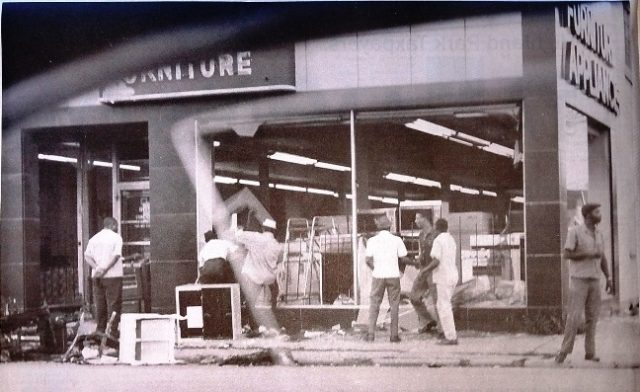
LIBERATING: The sense of exhilaration during the Rebellion was reflected in the vocabulary of many of those who participated it in or observed it. Some looters, like those shown here at United Furniture Co. at Harper Seneca on Detroit’s east side, on July 24, 1967, described their actions as “liberating,” not stealing goods. GIFT OF JAMES E. DAVIDSON, BURTON HISTORICAL COLLECTION.
When a friend called to tell him about the riot at 12th Street, E.G. went there expecting “a true revolt,” but was disappointed as soon as he saw the looting begin: “I wanted to see the people really rise up in revolt. When I saw the first person coming out of the store with things in his arms, I really got sick to my stomach and wanted to go home. Rebellion against the white suppressors is one thing, but one measly pair of shoes or some food completely ruins the whole concept.”
E. G. was standing in a crowd, watching firemen work, when Fire Chief Alvin Wall called out, asking for help from among the spectators. E. G. responded. His reasoning was: “No matter what color someone is, whether they are green or pink or blue, I’d help them if they were in trouble. That’s all there is to it.” He worked with the firemen for four days, the only Negro in an all-white crew. (Only 2.4 percent of the city’s firemen are Negro.) Elsewhere, at scattered locations, a half dozen other Negro youths pitched in to help the firemen.
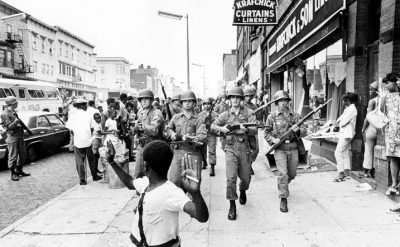
National Guard in Detroit during 1967 rebellion threaten child
At 4:20 P.M. Mayor Cavanagh requested that the National Guard be brought into Detroit. Although a major portion of the Guard was in its summer encampment 200 miles away, several hundred were conducting their regular week-end drill in the city, and the fact that the Guard was already on duty obviated many problems that would have otherwise arisen.
By 7:00 P.M. the first of the troops were on the streets. At 7:45 P.M. the mayor issued a proclamation instituting a 9:00 P.M. to 5:00 A.M. curfew. At 9:07 P.M. the first sniper fire was reported. Following his aerial survey of the city, Governor Romney, at or shortly before midnight, proclaimed that “a state of public emergency exists” in the cities of Detroit, Highland Park, and Hamtramck.
At 4:45 P.M. a 68-year-old white shoe repairman, [Krikor] George Messerlian, had seen looters carrying clothes from a cleaning establishment next to his shop. Armed with a saber, he had rushed into the street, flailing away at the looters. One Negro youth was nicked on the shoulder. Another, who had not been on the scene, inquired as to what had happened. After he had been told, he allegedly replied: “I’ll get the old man for you!”
Going up to Messerlian, who had fallen or been knocked to the ground, he began to beat him with a club. Two other Negro youths dragged the attacker away from the old man. It was too late. Messerlian died four days later in the hospital.
THE FIRST VICTIMS
At 9:15 P.M. a 16-year-old Negro boy, superficially wounded while looting, became the first reported gunshot victim. At midnight Sharon [or Sheren] George, a 23-year-old white woman, together with her two brothers, was a passenger in a car driven by her husband.
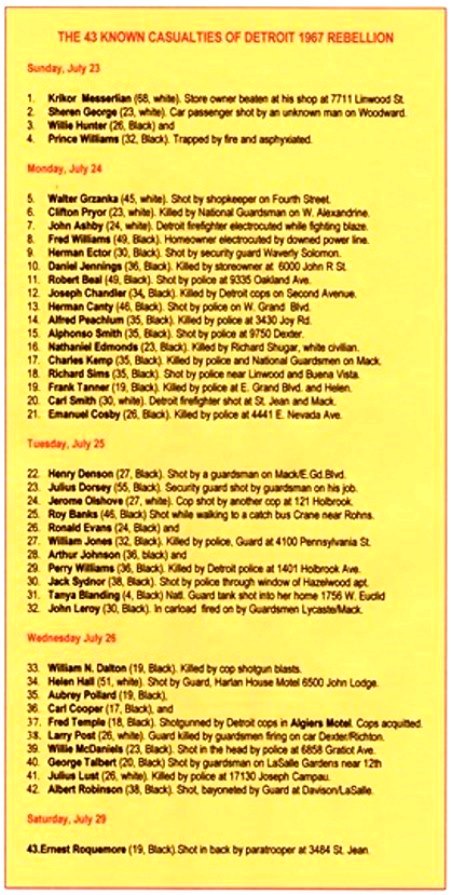 After having dropped off two Negro friends, they were returning home on one of Detroit’s main avenues when they were slowed by a milling throng in the street. A shot fired from close range struck the car. The bullet splintered in Mrs. George’s body. She died less than two hours later.
After having dropped off two Negro friends, they were returning home on one of Detroit’s main avenues when they were slowed by a milling throng in the street. A shot fired from close range struck the car. The bullet splintered in Mrs. George’s body. She died less than two hours later.
An hour before midnight a 45-year-old white man, Walter Grzanka, together with three white companions, went into the street. Shortly thereafter a market was broken into. Inside the show window a Negro man began filling bags with groceries and handing them to confederates outside the store. Grzanka twice went over to the store, accepted bags, and placed them down beside his companions across the street. On the third occasion he entered the market. When he emerged, the market’s owner, who was driving by in his car, shot and killed him.
In Grzanka’s pockets police found 7 cigars, 4 packages of pipe tobacco, and 9 pairs of shoelaces.
Before dawn four other looters were shot, one of them “accidentally” (VOD quotes) while struggling with a police officer. A Negro youth and a National Guardsman were injured by gunshots of undetermined origin. A private guard shot himself while pulling his revolver from his pocket. In the basement of the 13th Precinct Police Station a cue ball, thrown by an unknown assailant, cracked against the head of a sergeant.
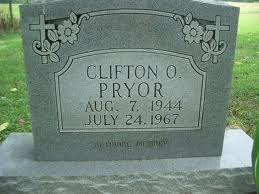
Clifton Pryor’s headstone.
At about midnight three white youths, armed with a shotgun, had gone to the roof of their apartment building, located in an all-white block, in order, they said, to protect the building from fire. At 2:45 A.M. a patrol car, carrying police officers and National Guardsmen, received a report of “snipers on the roof.” As the patrol car arrived, the manager of the building went to the roof to tell the youths they had better come down.
The law enforcement personnel surrounded the bui1ding, some going to the front, others to the rear. As the manager, together with the three youths, descended the fire escape in the rear, a National Guardsman, believing he heard shots from the front, fired at them once. The shot killed 23-year-old Clifton Pryor.
Early in the morning a young white fireman [John Ashby] and a 49-year-old Negro homeowner [Fred Williams] were killed by fallen power lines. By 2 o’clock Monday morning Detroit police had been augmented by 800 State Police officers and 1200 National Guardsmen. An additional 8,000 Guardsmen were on the way.
GOVERNOR’S QUANDARY
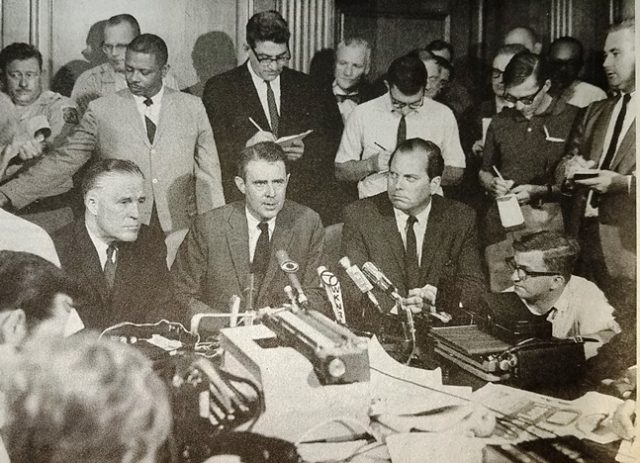
CRISIS SUMMIT: Seated from left, Michigan Gov. George W. Romney, Cyrus R. Vance, Pres. Lyndon B. Johnson’s special representative to Detroit, and Detroit Mayor Jerome P. Cavanaugh address a packed news conference July 24, 1967. Michigan Civil Rights Commission chairman Judge Damon J. Keith is behind Romney. GARY COOPERMAN PHOTO, DETROIT NEWS/BURTON HISTORICAL COLL. DETROIT PUBLIC LIBRARY
There is some difference of opinion about what occurred next. According to the Attorney General’s office the Governor was advised of the seriousness of the request and told that the applicable federal statute required that, before Federal troops could be brought into the city, he would have to state that the situation had deteriorated to the point that local and state forces could no longer maintain law and order. According to the governor, he was under the impression that he was being asked to declare that a “state of insurrection” existed in the city.
The governor was unwilling to make such a declaration, contending that, if he did, insurance policies would not cover the loss incurred as a result of the riot. He and the mayor decided to re-evaluate the need for federal troops.
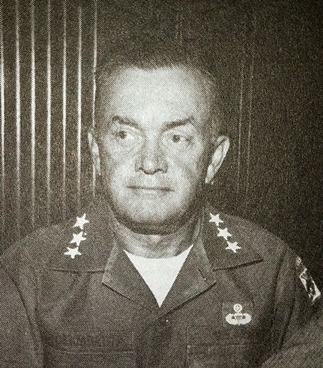
General John L. Throckmorton, Aug. 2, 1967
Contact between Detroit and Washington was maintained throughout the early morning hours. At 9:00 the disorder still showed no sign of abating. At one point, out of a total of 157 pieces of fire-fighting equipment, the department had only four to guard that portion of the city outside of the riot area. The governor and the mayor decided to make a renewed request for Federal troops. S
hortly before noon the President of the United States authorized the sending of a task force of paratroopers to Selfridge Air Force Base, near the city. A few minutes past 3:00 P.M., Lt. General John L. Throckmorton, commander of Task Force Detroit, met Cyrus Vance, Special Assistant to the Secretary of Defense, at the air base. Approximately an hour later the first troops began arriving.
After meeting with state and municipal officials, Mr. Vance and General Throckmorton, together with Governor Romney and Mayor Cavanagh, made a tour of the city, which lasted until 7:15 P.M. During this tour Mr. Vance and General Throckmorton came to the conclusion independently that — inasmuch as substantial numbers of the National Guard had not yet been committed, as they had seen no looting or sniping, and as the fires that were burning appeared to be coming under control — injection of Federal troops into the city would be premature.
NEIGHBORHOOD ACTION
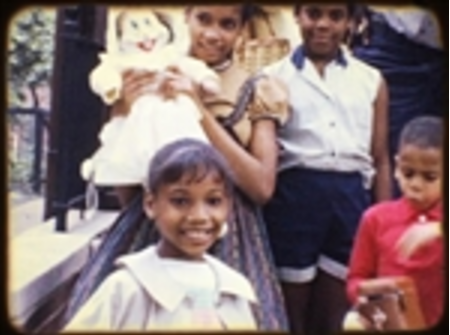
City did not provide playgrounds in many Black neighborhoods. PHOTO: from Detroit home movie
As the riot alternately waxed and waned, one area of the ghetto remained insulated. On the northeast side residents of some fifty square blocks inhabited by 21,000 persons had, in 1966, banded together in the Positive Neighborhood Action Committee (PNAC). With professional help from the Institute of Urban Dynamics, they had organized block clubs and made plans for the improvement of the neighborhood. In order to meet the need for recreational facilities, which the city was not providing, they had raised $3,000 to purchase empty lots for playgrounds. Although opposed to urban renewal, they had agreed to co-sponsor with the Archdiocese of Detroit a housing project to be controlled jointly by the archdiocese and PNAC.
When the riot broke out, the residents, through the block clubs, were able to organize quickly. Youngsters, agreeing to stay in the neighborhood, participated in detouring traffic. Even though many persons reportedly identified with the rioters as far as a rebellion against the “system” was concerned” only two small fires — one of them in an empty building — were set.
MORE VICTIMS
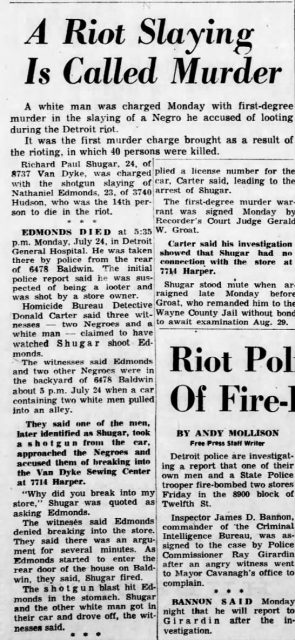
During the daylight hours Monday nine more persons were killed by gunshots elsewhere in the city, and many others were seriously or critically injured. Twenty-three year-old Nathaniel Edmonds, a Negro, was sitting in his backyard when a young white man stopped his car, got out, and began an argument with him. A few minutes later, declaring that he was “going to paint his picture on him with a shotgun,” the white man allegedly shotgunned Edmonds to death.
Mrs. Nannie Pack and Mrs. Mattie Thomas were sitting on the porch of Mrs. Pack’s house when police began chasing looters from a nearby market. During the course of the chase officers fired three shots from their shotguns. The discharge from one of these accidentally struck the two women. Both were still in the hospital weeks later.
Included among those critically injured when they were accidentally trapped in the line of fire were an 8-year-old Negro girl and a 14-year-old white boy.
As darkness settled Monday evening the number of incidents reported to police began to rise again. Although many turned out to be false, several of them involved injuries to police officers, national guardsmen, and civilians by gunshots of undetermined origin.
Watching the upward trend of reported incidents, Mr. Vance and General Throckmorton became convinced Federal troops should be committed to the streets of the city, and President Johnson was so advised. At 11:20 P.M. he signed a proclamation federalizing the Michigan National Guard and authorizing the use of the paratroopers. (Kerner report concludes in next issue.)
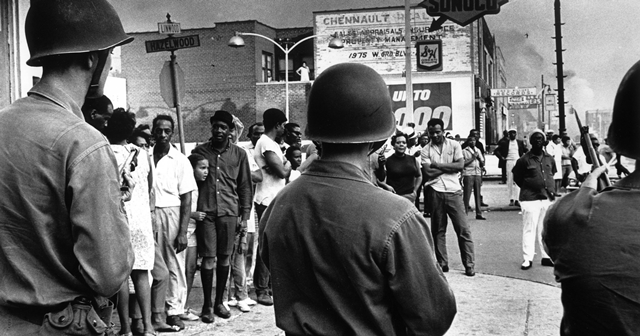
STAND-OFF: MEN, WOMEN AND CHILDREN FACE TROOPS ON THEIR STREETS.
PROFILE OF THE REBELLION, Pt. 3
Introduced and edited by Paul Lee
THE KERNER REPORT (conclusion):
‘Sniper, I guess’
At this time there were nearly 5,000 Guardsmen in the city, but fatigue, lack of training, and the haste with which they had had to be deployed reduced their effectiveness. Some of the Guardsmen traveled 200 miles and then were on duty for 30 hours straight. Some had never received riot training and were given on-the-spot instructions on mob control — only to discover that there were no mobs, and the situation which they faced on the darkened streets was one for which they were unprepared.
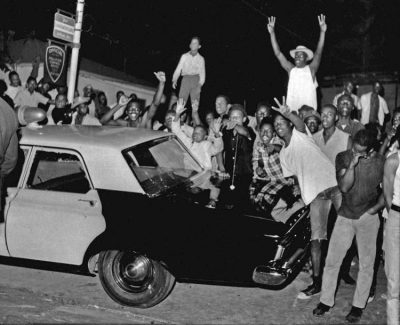
Watts rebellion, 1965
Commanders committed men as they became available, often in small groups, and, in the resultant confusion, some units were lost in the city. Two Guardsmen assigned to an intersection on Monday were discovered to be still there, without having been relieved, on Friday. Lessons learned by the California National Guard two years earlier in Watts regarding the danger of over-reaction and the great restraint necessary in the employment of weapons in a city had not, apparently, been passed on to the Michigan National Guard.
The young troopers could not be expected to know what a danger they were creating, not only to the civilian population but to themselves, by the lack of fire discipline. A Detroit newspaper reporter who spent one night riding in the command jeep of a column told a Commission investigator of machine guns being fired accidentally, street lights being shot out by rifle fire, and buildings being placed under siege on the most haphazard and sketchy reports of sniping.
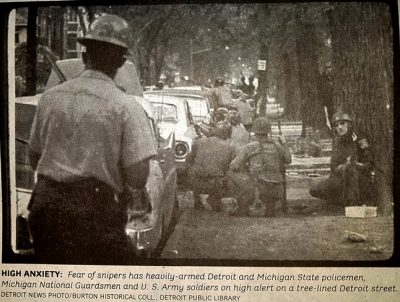 Troopers in the column he was accompanying would fire, and immediately from the distance there would be answering fire, sometimes consisting of tracer bullets. In one instance, he related, a report was received on the jeep’s radio that an Army bus was pinned down by sniper fire at an intersection. National Guardsmen and police, arriving from various directions, jumped out and began asking each other: “Where’s the sniper fire coming from?” As one Guardsman pointed to a building, everyone rushed about, taking cover.
Troopers in the column he was accompanying would fire, and immediately from the distance there would be answering fire, sometimes consisting of tracer bullets. In one instance, he related, a report was received on the jeep’s radio that an Army bus was pinned down by sniper fire at an intersection. National Guardsmen and police, arriving from various directions, jumped out and began asking each other: “Where’s the sniper fire coming from?” As one Guardsman pointed to a building, everyone rushed about, taking cover.
A soldier, alighting from a jeep, accidentally pulled the trigger on his rifle. As the shot reverberated through the darkness an officer yelled: “What’s going on?” “I don’t know,” came the answer. “Sniper, I guess.” Without any clear authorization or direction someone opened fire upon the suspected building. A tank rolled up and sprayed the building with .50 caliber tracer bullets. Law enforcement officers rushed into the surrounded building and discovered it empty.
“They must be firing one shot and running,” was the verdict. As this was occurring, the reporter went to the bus and interviewed the men who had gotten off and were crouched around it. When he asked them about the sniping incident he was told that someone had heard a shot. He asked: “Did the bullet hit the bus?” The answer was: “Well, we don’t know.”
AND MORE VICTIMS
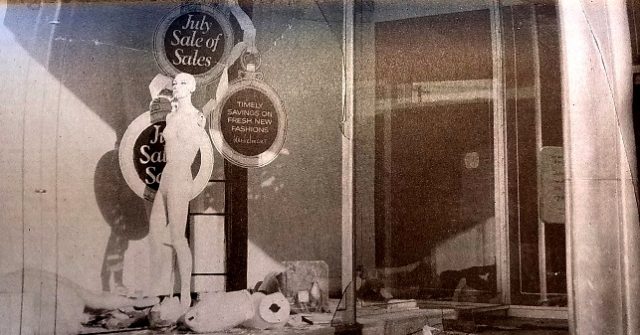
Looted Winkelman’s at Harper and Van Dyke on east side
Bracketing the hour of midnight Monday, heavy firing, injuring many persons and killing several, occurred in the southeastern sector, which was to be taken over by the paratroopers at 4:00 A.M. Tuesday, and which was, at this time, considered to be the most active riot area in the city.
Employed as a private guard, 55-year-old Julius L. Dorsey, a Negro, was standing in front of a market when accosted by two Negro men and a woman. They demanded he permit them to loot the market. He ignored their demands. They began to berate him. He asked a neighbor to call the police. As the argument grew more heated, Dorsey fired three shots from his pistol into the air. The police radio reported: “Looters, they have rifles.”
A patrol car driven by a police officer and carrying three National Guardsmen arrived. As the looters fled, the law enforcement personnel opened fire. When the firing ceased, one person lay dead. He was Julius L. Dorsey. In two separate areas — one consisting of a triangle formed by Mack, Gratiot, and E. Grand Boulevard, the other surrounding Southeastern High School — firing began shortly after 10:00 P.M. and continued for several hours thereafter.
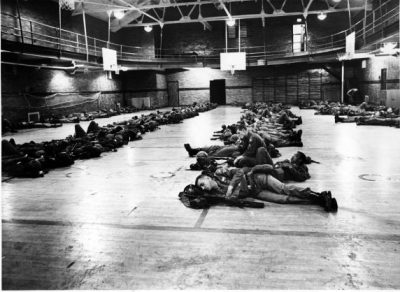
Troops bivouaced inside Southeastern High School.
In the first of the areas, a 22-year-old Negro complained that he had been shot at by snipers. Later, a half dozen civilians and one National Guardsman were wounded by shots of undetermined origin. Henry Denson, a passenger in a car, was shot and killed when the vehicle’s driver, either by accident or intent, failed to heed a warning to halt at a National Guard roadblock. Similar incidents occurred in the vicinity of Southeastern High School, one of the National Guard staging areas. As early as 10:20 P.M. the area was reported to be under sniper fire. Around midnight there were two incidents, the sequence of which remains in doubt.
SHOT IN THE DARK
Shortly before midnight Ronald Powell, who lived three blocks east of the high school and whose wife was, momentarily, expecting a baby, asked the four friends with whom he had been spending the evening to take him home. He, together with Edward Blackshear, Charles Glover, and John Leroy climbed into Charles Dunson’s station wagon for the short drive. Some of the five may have been drinking, but none was intoxicated.
To the north of the high school they were halted at a National Guard roadblock, and told they would have to detour around the school and a fire station at Mack and St. Jean Streets because of the firing that had been occurring. Following orders, they took a circuitous route and approached Powell’s home from the south.
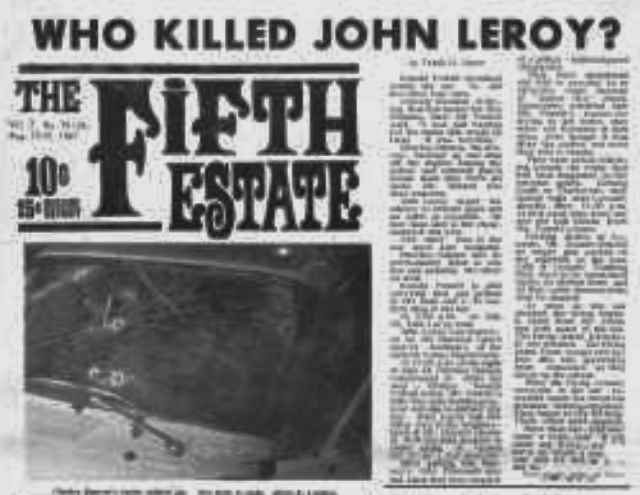
Fifth Estate newspaper questioned National Guard killing of John Leroy.
On Lycaste Street, between Charlevoix and Goethe, they saw a jeep sitting at the curb. Believing it to be another roadblock, they slowed down. Simultaneously a shot rang out. A National Guardsman fell, hit in the ankle. Other National Guardsmen at the scene thought the shot had come from the station wagon. Shot after shot was directed against the vehicle, at least 17 of them finding their mark. All five occupants were injured, John Leroy fatally.
FIREFIGHTER KILLED
At approximately the same time firemen, police, and National Guardsmen at the corner of Mack and St. Jean Streets, two and one-half blocks away, again came under fire from what they believed were rooftop snipers to the southeast, the direction of Charlevoix and Lycaste. The police and Guardsmen responded with a hail of fire. When the shooting ceased, Carl Smith, a young firefighter, lay dead. An autopsy determined that the shot had been fired at street level, and, according to police, had probably come from the southeast.
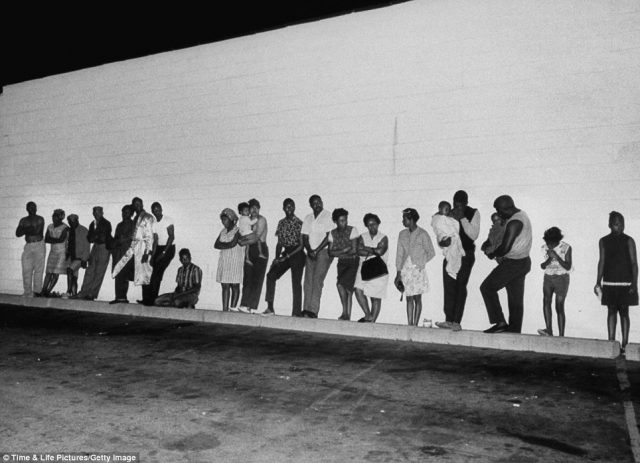
Apartment residents huddle outside after troops forced them to leave while they searched for alleged snipers.
At 4:00 A.M. when paratroopers, under the command of Col. A. R. Bolling, arrived at the high school, the area was so dark and still that the colonel thought, at first, that he had come to the wrong place. Investigating, he discovered National Guard troops crouched behind the walls of the darkened building, claiming they were pinned down by sniper fire.
The colonel immediately ordered all of the lights in the building turned on, and his troops to show themselves as conspicuously as possible. In the apartment house across the street nearly every window had been shot out, and the walls were pockmarked with bullet holes. The colonel went into the building and began talking to the residents, many of whom had spent the night huddled on the floor. He reassured them no more shots would be fired.
FEAR AND RAPPORT
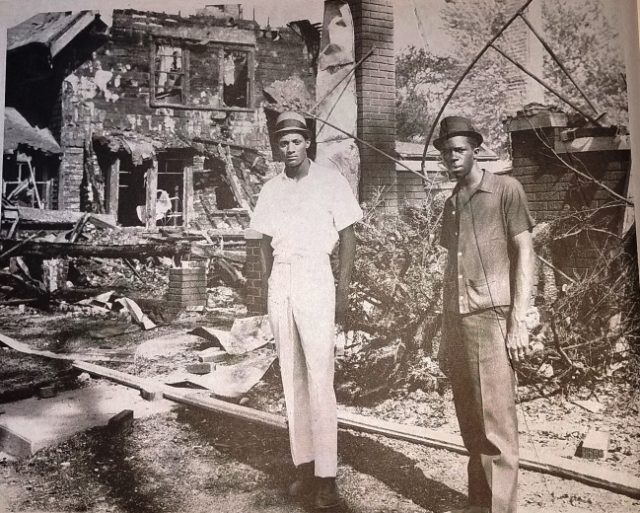
Youths outside burnt home at 12th and Pingree
According to Lt. Gen. [John L.] Throckmorton and Colonel Bolling, the city, at this time, was saturated with fear. The National Guardsmen were afraid, the residents were afraid, and the police were afraid. Numerous persons, the majority of them Negroes, were being injured by gunshots of undetermined origin.
The general and his staff felt that the major task of the troops was to reduce the fear and restore an air of normalcy. In order to accomplish this, every effort was made to establish contact and rapport between the troops and the residents. Troopers — slightly over 20 percent of whom were Negro — began helping to clean up the streets, collect garbage, and trace persons who had disappeared in the confusion. Residents in the neighborhoods responded with soup and sandwiches for the troops.

In those areas where the National Guard attempted to establish rapport with the citizens, there was a similar response. Within hours after the arrival of the paratroops the area occupied by them was the quietest in the city, bearing out General Throckmorton’s view that the key to quelling a disorder is to saturate an area with “calm, determined, and hardened professional soldiers.” Loaded weapons, he believes, are unnecessary.
Troopers had strict orders not to fire unless they could see the specific person at whom they were aiming. Mass fire was forbidden. During five days in the city, 2,700 Army troops expended only 201 rounds of ammunition, almost all during the first few hours, after which even stricter fire discipline was enforced. Although hundreds of reports of sniper fire — a majority false — continued to pour into police headquarters, the Army logged only 10 such incidents.
No paratrooper was injured by a gunshot. Only one person was injured by Army personnel. He was a young Negro [apparently Ernest Roquemore] who was killed when he ran into the line of fire as a trooper, aiding police in a raid on an apartment, aimed at a person he believed to be a sniper. General Throckmorton ordered the weapons of all military personnel unloaded, but the order either failed to reach or else was disobeyed by many National Guardsmen.
‘FIRING ACROSS THE BOW’
Even as the general was requesting the city to relight the streets, Guardsmen continued shooting out the lights, and there are reports of dozens of shots being fired to dispatch one light. At one such location, as Guardsmen were shooting out the streetlights, a radio newscaster reported himself to be pinned down by “sniper fire.”
On the same day that the general was attempting to restore normalcy by ordering street barricades taken down, Guardsmen on one street were not only, in broad daylight, ordering people off the street, but off their porches and away from the windows. Two persons who failed to respond to the order quickly enough were shot, one of them fatally.
The general himself reported an incident of a Guardsman “firing across the bow” of an automobile that was approaching a roadblock. As in Los Angeles two years earlier, roadblocks that were ill lighted and ill defined — often consisting of no more than a trash barrel or similar object with Guardsmen standing nearby — proved a continuous hazard to motorists.
At one such roadblock, National Guard Sergeant Larry Post, standing in the street, was caught in a sudden cross-fire from his fellow guardsmen as they opened up on a vehicle. He was the only soldier killed in the riot.
With persons of every description arming themselves, and guns being fired accidentally or on the vaguest pretext all over the city, it became more and more impossible to tell who was shooting at whom. Some firemen began carrying guns. One accidentally shot and wounded a fellow fireman. Another injured himself.
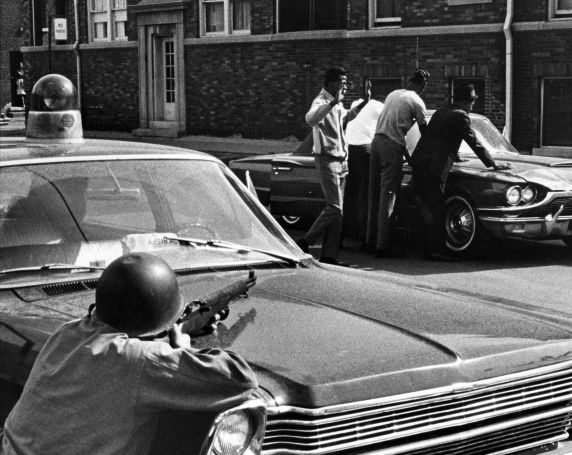
Under threat of death.
‘INFERNO OF GUNFIRE’
The chaos of a riot, and the difficulties faced by police officers, are demonstrated by an incident that occurred at 2 A.M. Tuesday. A unit of twelve officers received a call to guard firemen from snipers. When they arrived at the corner of Vicksburg and Linwood in the 12th Street area, the intersection was well-lighted by the flames completely enveloping one building. Sniper fire was directed at the officers from an alley to the north, and gun flashes were observed in two buildings.
As the officers advanced on the two buildings, Patrolman Johnie (sic) Hamilton fired several rounds from his machinegun. Thereupon, the officers were suddenly subjected to fire from a new direction, the east. Hamilton, struck by four bullets, fell, critically injured, in the intersection. As two officers ran to his aid, they too were hit.
By this time other units of the Detroit Police Department, State Police, and National Guard had arrived on the scene, and the area was turned into an inferno of gunfire. Amidst the confusion the snipers who had initiated the shooting escaped.
At 9:15 P.M. Tuesday, July 25, 38-year-old Jack Sydnor, a Negro, came home drunk. Taking out his pistol, he fired one shot into an alley. A few minutes later the police arrived. As his common-law wife took refuge in a closet, Sydnor waited, gun in hand, while the police forced open the door.
Patrolman Roger Poike, the first to enter, was shot by Sydnor. Despite being critically injured, the officer managed to get off six shots in return. Police within the building and on the street then poured a hail of fire into the apartment. When the shooting ceased, Sydnor’s body, riddled by the gunfire, was found lying on the ground outside a window.
Nearby, a State Police officer and a Negro youth were struck and seriously injured by stray bullets. As in other cases where the origin of the shots was not immediately determinable, police reported them as “shot by sniper.”
Tonya Blanding, 4
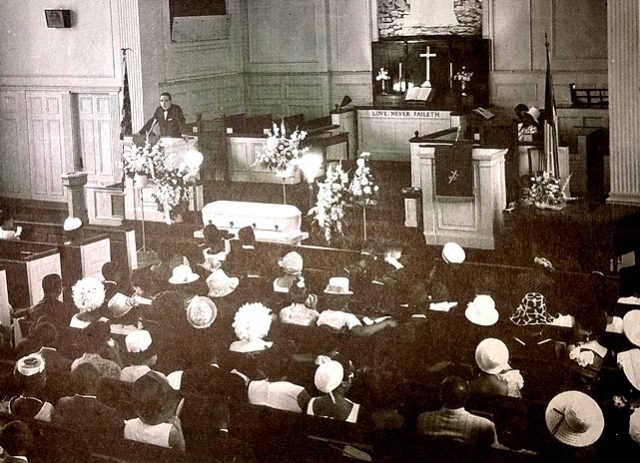
CENTRAL CHURCH: Rev. Albert B. Cleage Jr. conducting funeral service for 4-year-old Tonya Lynn Blanding, shot by a National Guardsman, Central United Church of Christ, Aug. 1, 1967. By year’s end, the membership of Cleage’s Black Christian Nationalist Church doubled. It was renamed the Shrine of the Black Madonna in 1970 and Cleage took the name Jaramogi Abebe Agyeman in 1972. DETROIT NEWS PHOTO/JARAMOGI ABEBE AGYEMAN ARCHIVES
As reports of “heavy sniper fire” poured into police headquarters from the two blocks surrounding the apartment house where the battle with Jack Sydnor had taken place, National Guard troops with two tanks were dispatched to help flush out the snipers. Shots continued to be heard throughout the neighborhood.
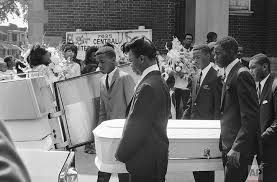
Pallbearers carry tiny casket of Tonya Blanding.
At approximately midnight — the precise time is difficult to pinpoint because of some discrepancies in the various reports — a machine gunner on a tank, startled by several shots, asked the assistant gunner where the shots were coming from. Seeing a flash in the window of an apartment house from which there had been earlier, reports of sniping, the assistant gunner pointed toward it. The machine gunner opened fire.
As the slugs ripped through the window and walls of the apartment, 21-year-old Valierie Hood had her arm nearly severed at the shoulder. Her 4-year-old niece, Tonya Blanding, toppled dead as a .50 caliber bullet plowed through her chest. A few seconds earlier, 19-year-old Bill Hood, standing in the window, had lighted a cigarette.
‘LOOK AT THE TANKS!’
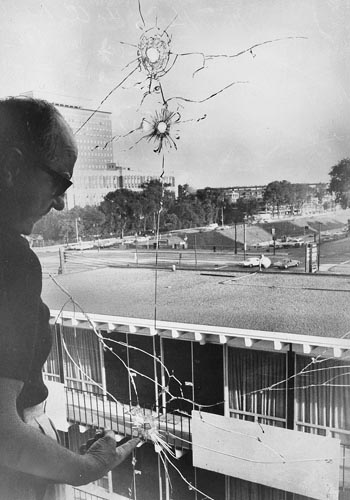
Bullet-riddled window at Harlan House Hotel where Helen Hall was shot to death by National Guard.
Down the street, a bystander was critically injured by a stray bullet. Simultaneously, the John C. Lodge Freeway, two blocks away, was reported to be coming under sniper fire. Tanks and National Guard troops were sent to investigate. At the Harlan House Hotel, ten blocks from where Tonya Blanding had died a short time earlier, Mrs. Helen Hall, a 51-year-old white businesswoman, opened the drapes of the fourth floor hall window. Calling out to other guests, she exclaimed: “Look at the tanks!”
She died seconds later as bullets began to slam into the building. As the firing ceased, a 19-year-old Marine P.F.C. [Private First Class], carrying a Springfield rifle, burst into the building. When, accidentally, he pushed the rifle barrel through a window, the firing commenced anew. The Marine, who had just decided “to help out” the law enforcement personnel, was exonerated in Mrs. Hall’s death.
A CONFUSED REPORT
R. R., a white 27-year-old coin dealer, had bought a three-story house on “L” Street, an integrated middle class neighborhood. In May of 1966, R. R., with his wife and child, had moved to New York and had rented the house to two young men. After several months he began to have problems with his tenants. On one occasion he reported to his attorney that he had been threatened by them.
In March of 1967, R. R. instituted eviction proceedings against the tenants. These were still pending when the riot broke out. Concerned about what might happen to the house, R. R. decided to fly to Detroit. On Wednesday, July 26, when he arrived at the house, he discovered the tenants were not at home.
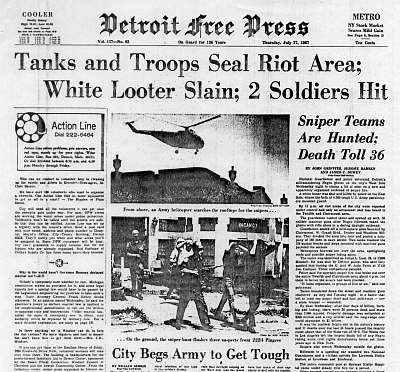
Tanks and troops in Detroit, 1967
R. R. then called his attorney, who advised him to take physical possession of the house, and, for legal protection, to take witnesses along. Together with his 17-year-old brother and another white youth, R. R. went to the house, entered, and began changing the locks on the doors. For protection they carried along a .22 caliber rifle. R. R.’s brother took the gun into the cellar and fired it into a pillow in order to test it.
Shortly after 8 P.M., R. R. called his attorney to advise him that the tenants had returned, and he had refused to admit them. Thereupon, R. R. alleged, the tenants had threatened to obtain the help of the National Guard. The attorney relates that he was not particularly concerned, and that he advised R. R. that if the National Guard did appear he should have the officer in charge call him (the attorney).
At approximately the same time the National Guard claims it received information to the effect that, several men had evicted the legal occupants of the house, taken in weapons and ammunition, barricaded the house, and intended to start sniping sometime after dark.
FIRE!
A National Guard column was dispatched to the scene. Shortly after 9 P.M., in the half-light of dusk, the column of approximately 30 men surrounded the house. A tank took position on a lawn across the street. The captain commanding the column placed in front of the house an explosive device similar to a firecracker. After setting this off in order to draw the attention of the occupants to the presence of the column, he called for them to come out of the house.
No attempt was made to verify the truth or falsehood of the allegations regarding snipers. When the captain received no reply from the house, he began counting to 10. As he was counting, he said, he heard a shot, the origin of which he could not determine. A few seconds later he heard another shot and saw a “fire streak” coming from an upstairs window. He thereupon gave the order to fire.
According to the three young men, they were on the second floor of the house and completely bewildered by the barrage of fire that was unleashed against it. As hundreds of bullets crashed through the first and second story windows and ricocheted off the walls, they dashed to the third floor. Protected by a large chimney, they huddled in a closet until, during a lull in the firing, they were able to wave an item of clothing out of the window as a sign of surrender. They were arrested as snipers.
The firing from rifles and machine guns had been so intense that in a period of a few minutes the house suffered more than $10,000 worth of damage. One of a pair of stone columns was shot nearly in half.
ALLEY COURT
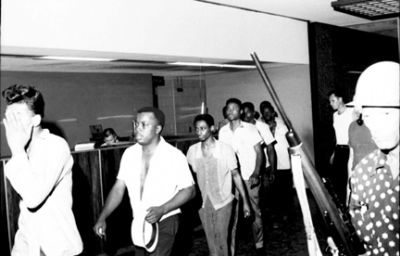
At the infamous 10th Precinct, known for police murders of Black men.
Jailed at the 10th Precinct Station, sometime Wednesday night R. R. and his two companions were taken from their cell to an “Alley Court,” police slang for an unlawful attempt to make prisoners confess. A police officer, indicted for the offense, allegedly administered such a severe beating to R. R. that the bruises still were visible two weeks later. R. R.’s 17-year-old brother had his skull cracked open, and was thrown back into the cell.
He was taken to a hospital only when other arrestees complained that he was bleeding to death. At the preliminary hearing twelve days later the prosecution presented only one witness, the National Guard captain who had given the order to fire. The police officer who had signed the original complaint was not asked to take the stand. The charges against all three of the young men were dismissed.
Nevertheless, the morning after the incident occurred a major metropolitan newspaper in another section of the country had composed the following banner story from wire service reports: “DETROIT, July 27 (Thursday) — Two National Guard tanks ripped a sniper’s haven with machine guns Wednesday night and flushed out three shaggy-haired white youths. Snipers attacked a guard command post and Detroit’s racial riot set a modern record for bloodshed. The death toll soared to 36, topping the Watts bloodbath of 1966 [1965] in which 35 died and making Detroit’s insurrection the most deadly racial riot in modern U. S. history. …
“In the attack on the sniper’s nest, the Guardsmen poured hundreds of rounds of .50 caliber machine gun fire into the home, which authorities said housed arms and ammunition used by West Side sniper squads.
“Guardsmen recovered guns and ammunition. A reporter with the troopers said the house, a neat brick home in a neighborhood of $20,000 to $50,000 homes, was torn apart by the machine gun and rifle fire.
“Sniper fire crackled from the home as the Guard unit approached. It was one of the first verified reports of sniping by whites. … “A pile of loot taken from riot-ruined stores was recovered from the sniper’s haven, located ten blocks from the heart of the 200-square block riot zone.
“Guardsmen said the house had been identified as a storehouse of arms and ammunition for snipers. Its arsenal was regarded as an indication that the sniping — or at least some of it — was organized.”
VANISHED DISCIPLINE
As hundreds of arrestees were brought into the 10th Precinct Station, officers took it upon themselves to carry on investigations and to attempt to extract confessions. Dozens of charges of police brutality emanated from the station as prisoners were brought in uninjured, but later had to be taken to the hospital. In the absence of the precinct commander, who had transferred his headquarters to the riot command post at a nearby hospital, discipline vanished.
Prisoners who requested that they be permitted to notify someone of their arrest were almost invariably told that: “The telephones are out of order.” Congressman [John] Conyers and State Representative [James] Del Rio, who went to the station hoping to coordinate with the police the establishing of a community patrol, were so upset by what they saw that they changed their minds and gave up on the project.
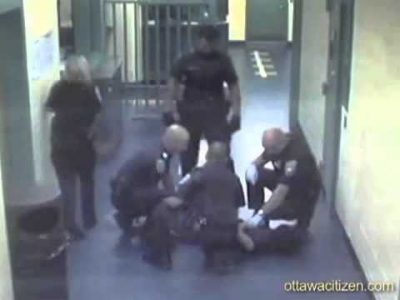
Generic photo: police force woman to strip.
A young woman, brought into the station, was told to strip. After she had done so, and while an officer took pictures with a Polaroid camera, another officer came up to her and began fondling her. The negative of one of the pictures, fished out of a wastebasket, subsequently was turned over to the mayor’s office.
Citing the sniper danger, officers throughout the department had taken off their bright metal badges. They also had taped over the license plates and the numbers of the police cars. Identification of individual officers became virtually impossible. On a number of occasions officers fired at fleeing looters, then made little attempt to determine whether their shots had hit anyone. Later some of the persons were discovered dead or injured in the street.
CONFLICTING TESTIMONY

From the Detroit Free Press.
In one such case police and National Guardsmen were interrogating a youth [apparently William N. Dalton] suspected of arson when, according to officers, he attempted to escape. As he vaulted over the hood of an automobile, an officer fired his shotgun. The youth disappeared on the other side of the car. Without making an investigation, the officers and Guardsmen returned to their car and drove off.
When nearby residents called police, another squad car arrived to pick up the body. Despite the fact that an autopsy disclosed the youth had been killed by five shotgun pellets, only a cursory investigation was made, and the death was attributed to “sniper fire.” No police officer at the scene during the shooting filed a report.
Not until a Detroit newspaper editor presented to the police the statements of several witnesses claiming that the youth had been shot by police after he had been told to run did the department launch an investigation. Not until three weeks after the shooting did an officer come forward to identify himself as the one who had fired the fatal shot. Citing conflicts in the testimony of the score of witnesses, the Detroit Prosecutor’s office declined to press charges.
THE ALGIERS MOTEL INCIDENT
Prosecution is proceeding in the case of three youths [Carl Cooper, Aubrey Pollard Jr. and Fred Temple] in whose shotgun deaths law enforcement personnel were implicated following a report that snipers were firing from the Algiers Motel.
In fact, there is little evidence that anyone fired from inside the building. Two witnesses say that they had seen a man, standing outside of the motel, fire two shots from a rifle. The interrogation of other persons revealed that law enforcement personnel then shot out one or more street lights. Police patrols responded to the shots.
An attack was launched on the motel. The picture is further complicated by the fact that this incident occurred at roughly the same time that the National Guard was directing fire at the apartment house in which Tonya Blanding was killed. The apartment house was only six blocks distant from and in a direct line with the motel.
The killings occurred when officers began on-the-spot questioning of the occupants of the motel in an effort to discover weapons used in the “sniping.” Several of those questioned reportedly were beaten. One was a Negro ex-paratrooper [Robert Green] who had only recently been honorably discharged, and had gone to Detroit to look for a job.
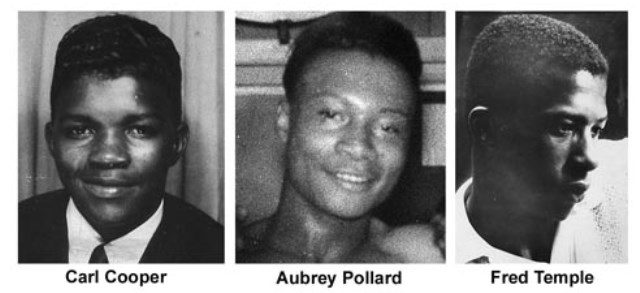
EXECUTED BY DETROIT COPS WHO FOUND THEM WITH WHITE WOMEN AT ALGIERS MOTEL DURING REBELLION
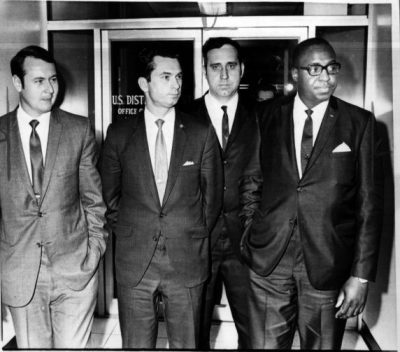
Cops who killed the three young men were later acquitted.
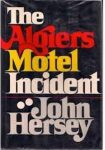
John Hersey broke the true story of the Algiers Motel executions in this book.
“EVERYONE’S SUSPECT Although by late Tuesday looting and fire-bombing had virtually ceased, between 7:00 and 11:00 P.M. that night there were 444 reports of incidents. Most were reports of sniper fire. During the daylight hour of July 26th, there were 534 such reports. Between 8:30 and 11:00 P.M. there were 255.
As they proliferated, the pressure on law enforcement officers to uncover the snipers became intense. Homes were broken into. Searches were made on the flimsiest of tips. A Detroit newspaper headline aptly proclaimed: “Everyone’s Suspect in No Man’s Land.”
Before the arrest of a young woman IBM operator in the city assessor’s office brought attention to the situation on Friday, July 28th, any person with a gun in his home was liable to be picked up as a suspect.
Of the 27 persons charged with sniping, 22 had charges against them dismissed at preliminary hearings, and the charges against two others were dismissed later. One pleaded guilty to possession of an unregistered gun and was given a suspended sentence. Trials of two are pending.
ARRESTS, MAKESHIFT JAILS, AND HIGH BAILS
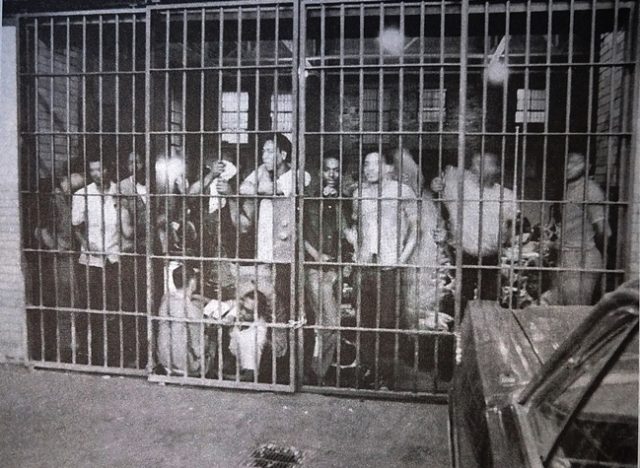
WAREHOUSED: Prisoners held in one of the many overcrowded police garages, July 27, 1967. According to the Kerner report, the police dragnet swept up 7,200 persons, many of whom had to be detained in jails in Ingham, Monroe and Washtenaw counties, the state prisons at Jackson and Ionia, and the federal prison at Milan. DETROIT NEWS PHOTO
In all, more than 7,200 persons were arrested. Almost 3,000 of these were picked up on the second day of the riot, and by midnight Monday 4,000 were incarcerated in makeshift jails. Some were kept as long as 30 hours on buses. Others spent days in an underground garage without toilet facilities. An uncounted number were people who had merely been unfortunate enough to be on the wrong street at the wrong time.
Included were members of the press whose attempts to show their credentials had been ignored. Released later, they were chided for not having exhibited their identification at the time of their arrests.
The booking system proved incapable of adequately handling the large number of arrestees. People became lost for days in the maze of different detention facilities. Until the later stages, bail was set deliberately high, often at $10,000 or more. When it became apparent that this policy was unrealistic and unworkable, the Prosecutor’s office began releasing on low bail or on their own recognizance hundreds of those who had been picked up. Nevertheless, this fact was not publicized for fear of antagonizing those who had demanded a high-bail policy.
ADDING UP THE TOLL
Of the 43 persons who were killed during the riot, 33 were Negro and 10 were white. Seventeen were looters, [including Julius Lawrence] of whom two were white. Fifteen citizens (of whom four were white [Larry Post]), one white National Guardsman, one white fireman, and one Negro private guard [Julius Dorsey] died as the result of gunshot wounds.
Most of these deaths appear to have been accidental, but criminal homicide is suspected in some. (VOD: police identified most people killed as looters, without proof. Cops and military were simply on a racist rampage.) Two persons, including one fireman, died as a result of fallen power lines. Two were burned to death [Willie Hunter and Prince Williams]. One was a drunken gunman; one an arson suspect.
One was a white man killed by a rioter. One was a police officer [Jerome Olshovo] felled by a shotgun blast when his gun, in the hands of another officer, accidentally discharged during a scuffle with a looter.
Action by police officers accounted for 20 and, very likely, 21 of the deaths. Action by the National Guard for seven, and, very likely, nine. Action by the Army for one. Two deaths [Nathaniel Edmonds and Daniel Jennings] were the result of action by store owners. Four persons died accidentally. Rioters were responsible for two, and perhaps three of the deaths; a private guard for one [Herman Ector].
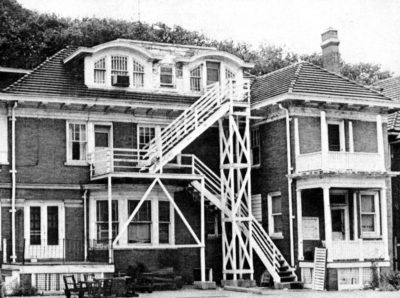
Rear of Algiers motel, through which police, Guard and army raided and murdered three Black youths, beat seven others and arrested three white females. Detroit cops Melvin Senak, Ronald August, and David Paille, along with security guard Melvin Dismukes, were charged but not convicted in close-range shotgun executions. Senak had already killed two others during rebellion. .
A white man is suspected of murdering a Negro youth. The perpetrator of one of the killings in the Algiers Motel remains unknown. Damage estimates, originally set as high as $500 million, were quickly scaled down. The city assessor’s office placed the loss — excluding business stock, private furnishings, and the buildings of churches and charitable institutions — at approximately $22 million. Insurance payments, according to the State Insurance Bureau, will come to about $32 million, representing an estimated 65 to 75 percent of the total loss.
By Thursday, July 27, most riot activity had ended. The paratroopers were removed from the city on Saturday. On Tuesday, August 1, the curfew was lifted and the National Guard moved out.
We would like to thank the Lyndon Baines Johnson Library and Museum, Austin, Tex.; the Walter P. Reuther Library, Wayne State University, Detroit; the Burton Historical Collection, Detroit Public Library; and Bob Houlihan, Danielle Kaltz and Pat Zacharias of The Detroit News for their kind and professional assistance. — PL. Copyright © 2007 by Paul Lee
JUSTICE ABUSED: THE KAMISAR STUDY
Introduced and edited by Paul Lee, Pt. 4
In the wake of over a hundred urban uprisings in 1967, the most destructive of which occurred in Detroit in late July, President Lyndon B. Johnson appointed an 11-member National Advisory Commission on Civil Disorders, headed by Illinois Gov. Otto Kerner, Jr., to uncover the causes of these upheavals and make recommendations to prevent or contain future disorders.
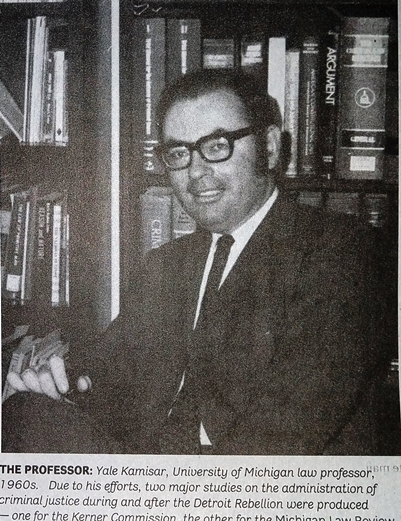 The Kerner Commission, as it came to be known, not only dispatched field investigators to the affected cities, but also engaged expert consultants to study specific aspects of the uprisings, including the response of local criminal justice systems.
The Kerner Commission, as it came to be known, not only dispatched field investigators to the affected cities, but also engaged expert consultants to study specific aspects of the uprisings, including the response of local criminal justice systems.
Yale Kamisar, then a young law professor at the University of Michigan, Ann Arbor, submitted a penetrating study on “Some Salient Features of the Administration of Criminal Justice During and After the July 23-28, 1967 Detroit ‘Riots,’” dated Oct. 5, 1967, published below in its entirety.
It reveals shocking abuses that were mostly ignored by the mainstream media, locally and nationally. Interestingly, Prof. Kamisar’s study was partly based on research conducted by his students.
In a recent interview with The Michigan Citizen, Prof. Kamisar, now a nationally recognized authority on constitutional law and criminal procedure and the Clarence Darrow Distinguished University Professor of Law Emeritus at the UM Law School, recalled how he encouraged students, including two members of the Michigan Law Review, to make an on-the-ground investigation.
While learning theory in class was important, he told them, the best way to learn the law would be for them to “go to Detroit.” In doing so, he added, they would also be recording a significant historical event.
In the immediate wake of the rebellion, the students interviewed defendants in regular jails, makeshift detention centers and courtrooms, as well as defense attorneys, prosecutors and judges. Their 86-page study, “The Administration of Justice in the Wake of the Detroit Civil Disorder of July 1967,” was published in the Michigan Law Review, vol. 66, no. 7 (1968), pp. 1544-1630.
“The Constitution and its guarantees,” it concluded, “are applicable to all citizens at all times. Panic, disorganization, and lack of preparation should never excuse granting a defendant less than his full measure of constitutional rights.”
Although drawing upon the students’ research, Prof. Kamisar’s study had the advantages of being blunt, succinct and more comprehensive in its treatment. It documented how, in a climate of fear and uncertainty, the police, the Wayne County prosecutor and the judges on the now-defunct Recorder’s Court — with the notable exception of Judge George W. Crockett, Jr. — worked together to sweep up and incarcerate, often on flimsy grounds and in deplorable conditions, thousands of persons alleged to have been involved in the “riot,” or merely thought to have the potential to do so, usually because they were young and Black.
The only changes we have made in the Kamisar report are to render underscored passages in italics and silently correct obvious misspellings.
THE KAMISAR STUDY
I. ARREST vs. SUMMONS
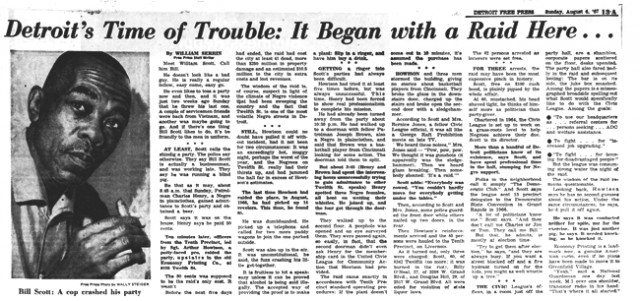
Bill Scott, respected businessman who owned site of after-hours hall, is interviewed.
Click on http://voiceofdetroit.net/wp-content/uploads/Bill_Scott_interviewed__aug_6_1967.pdf on to read story above.
The incident which immediately preceded and “set off” the riot was the arresting of some eighty people in a “blind pig” raid in the early hours of July 23, Sunday morning. The police did not have adequate facilities to whisk off so many arrestees and in the considerable time it took to do so a crowd gathered.
This incident illustrates the value of the summons over arrest. It appears that if the police could have issued summonses to most and only arrested one or two, no crowd would have gathered. The police should have anticipated that congregating scores of arrestees in the street would attract many bystanders — and that if they arrested only one or two and handed out “tickets” to the rest — trouble would have been avoided. Although the “blind pig” had been under surveillance for some time, the police were unprepared and ill-equipped to handle the many people they found there.
II. ARREST, SEARCH AND SEIZURE
Police tactics, once the “riot” began, were to spread a huge net over the riot area and more or less pull in everyone on the street, including many in moving cars. It is clear that at least an appreciable number of Negro citizens totally uninvolved in the riot were swept up and subject to degrading conditions in jails for periods up to several weeks before being released.
The Governor’s Emergency Proclamation imposed a nighttime curfew except for “emergency.” But what kind? A medical emergency? Looking for your lost children? Trying to buy milk or food for your children? Getting somebody to repair your car, so it could operate? Could a person of ordinary intelligence understand what “emergency” meant?
With respect to searches, police attempted to standardize a procedure whereby special “search units” allegedly acted on the tremendous number of tips pouring in about the location of stolen property. Acting without search warrants, the police had to rely on the “consent” of the occupants.
It is doubtful that the police had that many tips; there is reason to think that at least some units used so-called “tips” as an excuse for systematic searching of certain areas. It is doubtful that very many, if any, of the “waivers” obtained by heavily armed law enforcement officers operating in a “war atmosphere” were valid.
After a few days, the officers had available” printed forms which consenting occupants had to sign when giving permission, but it is doubtful whether many of these “waivers” were valid either. There were numerous complaints that the failure to produce a receipt for goods meant police confiscation of those goods. On August 7, these printed forms were amended to make it clear occupants could refuse permission.
These “search” practices bred much resentment in the Negro community. Of course, there was pressure from store owners to recover their goods, but it is questionable whether the police should have tried to do this while “the shooting” was still going on. Apparently the police started searching on the 26th of July and the situation was not under control until the 28th.
Considering other priorities, it seems the better course would have been to forget about searching for stolen property until the last shot had been fired and the smoke had settled. When the riot was over, many people began turning in stolen property on their own, no questions asked, some pretty weak excuses volunteered, e.g., I woke up and found this TV set in my bedroom; I don’t know how it got here; a friend must have put it here.
III. BAIL; DETENTION CONDITIONS
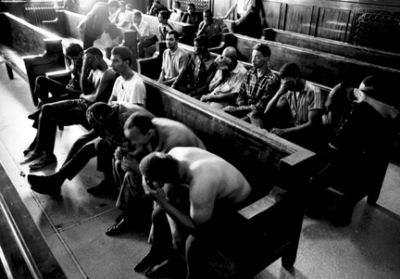
“Assembly-line” arraignments took place; prisoners were given high bail and locked up for weeks.
The most flagrant abuses probably occurred with respect to bail. The Recorder’s Court acted as a “law enforcement agency” determined to keep the arrested Negroes off the streets. With the exception of one or two judges, even bond for curfew violators was rarely, if ever, set at less than $10,000 and sometimes at $15,000 or $25,000.
Judge George Crockett, a Negro, who is one of the thirteen judges of Recorder’s Court, stated publicly at an NAACP state convention held on September 30 that most of the judges instructed the sheriff not to release an arrestee even if he could meet this high bond, but to check back with the judge who had set the bail, “presumably so that he could raise it still higher.”
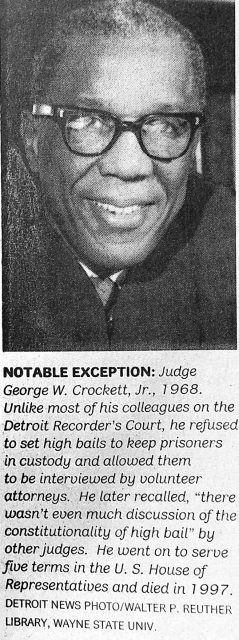 Judge Crockett (who said he and one or two other judges didn’t go along with this approach) indicated that the thinking of his brethren was that if anybody could meet the high bail “he must be a riot ‘leader.’”
Judge Crockett (who said he and one or two other judges didn’t go along with this approach) indicated that the thinking of his brethren was that if anybody could meet the high bail “he must be a riot ‘leader.’”
Another factor contributing to prolonged detention was the apparent policy of the Governor, prosecutors — and most judges — to release no one until records were checked with the FBI to ascertain whether any prisoners were connected with Watts, Newark or other riot spots and hence “ringleaders” or “outside agitators.”*
For the first five days after the riots began the great majority of judges made no allowance whatever for individual factors affecting the likelihood of the prisoner’s appearance for trial. In the first five days at least, the great majority of the judges of Recorder’s Court did not bother to make any inquiry with respect to the prisoner’s years of residence, job, property ownership, number of children in school, prior record, etc. Not infrequently husband and wife were remanded to the custody of the sheriff with high bonds when their children were home alone.
Five days’ after the riots began, the prosecutor started to move to reduce bail — on the basis of only one factor: “previous arrest” record. Apparently it was easier to find “previous arrests” data than “conviction” data. It is unclear what arrests were included, e.g., drunken driving. But apparently “arrest for investigation of…” were included.
Figures our students have obtained disclose that slightly over 3,000 of the 6,000 prisoners had a “previous arrest” record. The process of reviewing bail went on slowly for several weeks and many were in jail for a full month. A number may still be. Even if a prisoner’s bail was reduced, as late as the second week after the riots began it would still often take two or three days to locate him in one of the seven different places of detention. Those in charge of the custody of the prisoners were extremely inefficient and much confusion reigned. Prisoners frequently were not transported to the court on time. There were many reports of “lost” prisoners.
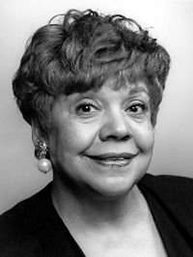
Claudia Morcom went on to become a Recorders Court Judge and civil rights activist known for her integrity.
Mrs. Claudia Marcom, Program Administrator, Neighborhood Legal Services, stated at the aforementioned NAACP convention that literally thousands of phone calls to the police or the sheriff’s office were made by those trying to locate missing relatives or friends, and all these calls were referred to her office.
There were horribly inadequate detention facilities. For example, some 1,000 prisoners were housed in an underground police garage for at least several days. It is doubtful many of these people could find enough room on the floor to sleep or that they could use toilet facilities when needed.
There was bitter comment at the NAACP meeting about Negro prisoners being “herded like cattle,” about degrading, brutalizing experiences, about Negroes being forced to stand for many hours or even days, and about men, women and the elderly all being incarcerated together.
More use of out-Detroit jail facilities should have been made. Quite possibly military installations outside Detroit might have been used. Judge Crockett (and perhaps one other judge) departed from the general pattern, releasing about 10 per cent of the prisoners appearing before him on personal recognizance, otherwise frequently setting bail in the neighborhood of $500-$1,500.
He had volunteer lawyers interview the prisoners about their roots in the community, etc., and relied on their recommendations. Apparently, he processed about as many prisoners about as rapidly as his “mechanical” brethren. The Wayne County Circuit Court, whose regular activities had ceased anyhow, whose twenty-seven judges amounted to double the judicial manpower in the Recorder’s Court, offered their judicial and clerical help for bail-setting and other matters, but this offer was refused, apparently on the ground that it wasn’t needed.
Many observers believe that the Recorder’s Court interpreted this offer as an implied criticism. It should be pointed out that a bill is coming up this fall proposing the merger of the two courts and the Recorder’s Court judges desire strongly to retain their independent existence.
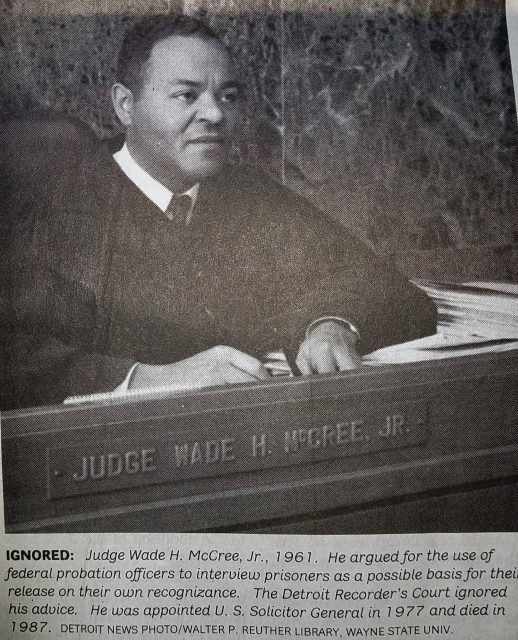 Another suggestion that went unheeded was the use of federal probation personnel and possibly the Wayne County probation staff as well to interview the prisoners and on the basis of certain factors release some on personal recognizance. Judge Wade McCree of the U.S. Court of Appeals for the Sixth Circuit (an outstanding judge who happens to be a Negro) whose chambers are in Detroit, was one of those who made this suggestion. (He personally told me this during a three hour interview I had with him.)
Another suggestion that went unheeded was the use of federal probation personnel and possibly the Wayne County probation staff as well to interview the prisoners and on the basis of certain factors release some on personal recognizance. Judge Wade McCree of the U.S. Court of Appeals for the Sixth Circuit (an outstanding judge who happens to be a Negro) whose chambers are in Detroit, was one of those who made this suggestion. (He personally told me this during a three hour interview I had with him.)
He proposed that those with two or more “favorable criteria” (considering residence, property, job with seniority, children, no prior record) be released on personal recognizance. Judge McCree is confident that 100 experienced federal probation people would have been available, if the Recorder’s Court had so desired.
Judge McCree, and probably others, also suggested that volunteer lawyers be “deputized” as special prosecutors (again, at least 100 could have been utilized) and, employing the prosecutor’s standards, go into the jails, question prisoners and recommend that substantial numbers of cases, e.g., curfew violations, be “nolle possed” — recommendations and supporting memoranda to be reviewed by the regular prosecutor’s staff. This suggestion, too, was rejected.
It seems that at least alleged curfew violators (about 1200) could have been released on personal recognizance even when the shooting was still going on. At the very least, this should have been done for those with no previous record. Many close observers feel that even those alleged curfew violators who were not totally innocent were very unlikely to give anybody any trouble after one or two days in jail. They had gone through enough. “The party was over” for them.
At any rate, whatever risk was involved in releasing these people seemed outweighed by the need to alleviate family hardships (e.g., children back home without parents), to reduce the tremendous strain on detention facilities, and to relieve hundreds of a degrading and embittering experience.
Just prior to the preliminary examinations, many prisoners had their high bonds reviewed. Apparently this was often done by the prosecutor’s office and the judges working in concert. In addition to the high bonds designed for preventive detention and the inefficiency of the Sheriff’s office, the writ of habeas corpus was in effect “suspended” for at least the first week after the riots began.
The volunteer attorneys did not attempt the use of this writ and the few retained attorneys who did got nowhere. Several lawyers involved in the processing insist that various judges simply announced and/or put up signs that they would not entertain the writ. They were also told of the great difficulties involved in trying to find the prisoners. Apparently some judges did state that “they would hear no petitions for a week.”
IV. THE RIGHT TO COUNSEL — AND TO “EFFECTIVE” COUNSEL
At the preliminary examination stage, there was a massive effort by various members of the bar to organize a group of volunteer attorneys to provide free defense services for those in need and several hundred attorneys turned out. Headquarters were set up in an empty courtroom in Recorder’s Court and before each morning and afternoon session volunteers with little or no criminal law experience were instructed as to law and practice.
Mimeographed pamphlets containing much practical advice were distributed daily. Some of the judges, who apparently viewed these lawyers as part of the law enforcement machinery, complained bitterly about these “instant criminal law courses,” which, for example, sought to “exploit” the difficulties the prosecution would face in relocating guardsmen to identify offenders.
Although many of the “volunteers” took their jobs quite seriously there were the to-be-expected complaints that some (but apparently only a small minority) just went through the motions and did view their jobs as “accommodating” the courts. More data is needed on this aspect of the processing. One administrative point should be made. After a volunteer completed an examination he usually left the court, period.
What should have been done was to report the disposition of the case to “volunteer headquarters” so that interested persons would know whether a prisoner had been released or was still in jail (and what jail) and whether a habeas corpus petition should be brought. In short, these volunteers did little to mitigate the confusion about where the arrestees were.
At the “arraignment on the information” stage — the last step prior to the trials scheduled to begin in January, 1968, probably about 80% were assigned counsel. Many close observers report that most judges made too much use of the criminal lawyer “regulars” and little or no use of volunteer lawyers.
There is reason to think this was for “patronage” purposes, and/or because the regulars would more often cop a plea and the volunteers would more often demand a trial (assigned counsel is paid on a “straight fee” basis and therefore it is against his economic interests to go to trial).
Since the last shot had long since been fired, at this stage, at least, one would have expected the proceedings to be conducted with care and dignity. But typically only one or two attorneys were appointed at the rate of $200 per day to represent all the defendants needing counsel in a given courtroom on a given day, probably 70-l00 defendants. (The days our students were there, only one assigned counsel was working in a given courtroom.)
The only reason advanced in support of this practice was economy. If individual lawyers had been assigned to represent individual defendants at the standard fee of $25 or $30 per “arraignment on the information,” this would have cost the county an estimated additional $1500-$2000 per day.
What little can be said for this economy argument in light of the important issues at stake is further diminished by the availability of at least a hundred volunteer lawyers who would have served without any compensation, most probably would have assured each defendant much more individualized treatment — but, from the point of view of the courts and the prosecutor, would have been much less “cooperative” and “accommodating.”
It is most doubtful that many defendants had anything approaching “effective counsel.” There was barely time in many instances for a lawyer to talk to his “client.” Our students witnessed an incident where a lawyer consulted with his “client” about the advisability of pleading guilty while both were standing in front of the judge in front of an open microphone.
Because, as might be expected, a great deal of “plea bargaining” occurred at this point, it was a most “critical stage.” It appears that in many cases the prosecutor’s office exercised plenary power in deciding whether or not to reduce a charge from a felony, often “entering without breaking with intent to commit larceny” (carrying a five year maximum) to a misdemeanor, say “entering without permission” (carrying a ninety day maximum) and frequently did so solely on the basis of one factor — whether or not the defendant had a prior criminal record.
The lack of justice, or at least the lack of “appearance of justice” was aggravated by judicial practice. For example, several justices mechanically sentenced every “guilty plea defendant” to time he “already served” up to that point and gave him credit for that time, so that he could walk out free — but with a misdemeanor conviction.
In effect, these judges communicated to those defendants with no prior records “waiting on line” the quid pro quo for pleading guilty. These tactics exerted enormous pressure on these defendants to plead guilty to a misdemeanor “just to get it over with” and finally “get out.”
At least one assigned counsel told our Law Review students working on this project that a number of his “clients” who swore their innocence to him yielded to the pressure.
Whatever can be said by way of mitigation of the deficiencies in the early stage because of the “war atmosphere” is inapplicable to the “arraignment on the information” stage. The “assembly line” methods at this relatively late step in the criminal process seems least defensible of all. *Apparently, none were found to be connected with other riots but some of the prisoners turned out to be wanted by the local police for other offenses.
We would like to thank the Lyndon Baines Johnson Library and Museum, Austin, Tex., for the Kamisar report; the Burton Historical Collection of the Detroit Public Library, The Detroit News, Barbara Scanlon of the UM Law Library, Tom Rogers, editor of the Law Quadrangle Notes, UM Law School, and the Walter P. Reuther Library, Wayne State University, Detroit, for the photographs; and Prof. Yale Kamisar for permission to publish his report and for kindly granting a brief interview. — Copyright © 2007 by Paul Lee
Rare testimonies and reports on the ’67 Detroit Rebellion
UPRISING!
AN ARRESTEE SPEAKS
Introduced and edited by Paul Lee Pt. 5
In the first four installments of our extended series on the Detroit Rebellion of July 23-27, 1967, the most destructive in U. S. history up to that point, The Michigan Citizen published two important studies on the uprising and its immediate aftermath. Firstly, the generally reliable “profile” of the Rebellion from the original text of the final report of President B. Johnson’s 11-member National Advisory Commission on Civil Disorders, or Kerner Commission, first published on March 1, 1968.
It was written by Dr. Nathan S. Caplan, a commission consultant, who was a program associate at the Survey Research Center of the University of Michigan’s Institute for Social Research (ISR). Secondly, a blunt and penetrating study by University of Michigan law professor Yale Kamisar, previously unpublished, on the administration of criminal justice during and after the Rebellion, dated Oct. 5, 1967.
INTERVIEWEE
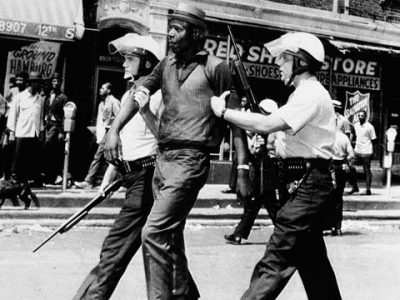
Youth arrested by Detroit police during 1967 rebellion. (He is not the interviewee in this story.)
Beginning in this week’s issue, we will take a more personal approach by drawing upon the dozens of interviews conducted by Kerner Commission field investigators and consultants with a wide variety of witnesses who actually lived the events of July 1967 and its aftermath and recount them in vivid detail.
We begin with the first part of a compelling three-part interview with an anonymous “arrestee,” a young black man who lived near the epicenter of the Rebellion, who recounts in frank, often raw language and harrowing detail his experiences during the crisis, which ran the gamut of many of the worst abuses by the police, military and courts.
He was arrested on the first day of the Rebellion, apparently for no other reason than that he was young and Black. He was incarcerated in hot, over-crowded jails, including an underground police garage that was too filthy and jam-packed to allow the prisoners to sleep. He was also held for hours, with little water, virtually no food and only primitive sanitary facilities, on a Department of Street Railways (DSR) bus and served a brief stint in “Belcatraz,” the makeshift detention center at the women’s bathhouse at Belle Isle in the Detroit River.
Like thousands of other prisoners, he was initially not allowed to contact his relatives or friends and was herded through one of the “assembly line” mass arraignments in the now-defunct Detroit Recorder’s Court.
INTERVIEWER
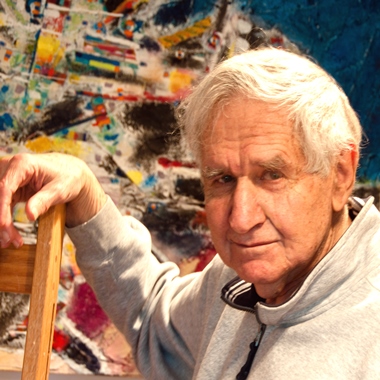
Dr. Nathan Caplan today
Dr. Nathan Caplan, now an ISR research scientist emeritus and professor of psychology emeritus, conducted the interview on Nov. 4, 1967, three months after the uprising. The transcript filled 26 typed, single-spaced pages. In the interview, Dr. Caplan is referred to as “C” and the arrestee as “W” for witness.
Dr. Caplan recently told The Michigan Citizen how he became involved in studying the Rebellion: “I was in Detroit, on 12th Street, the second day of the riot. … I knew that I would be able to get funds to study what was happening and I strongly believed then, and even more so forty years later, that studying social issues without firsthand experience with their reality is fraught with problems of data-interpretation and fairness to those affected by events such as what occurred in Detroit.”
“I was compelled to go into Detroit,” he continued, “so that the research would be grounded in reality, and not be based on statistical deductions free of that experience.”
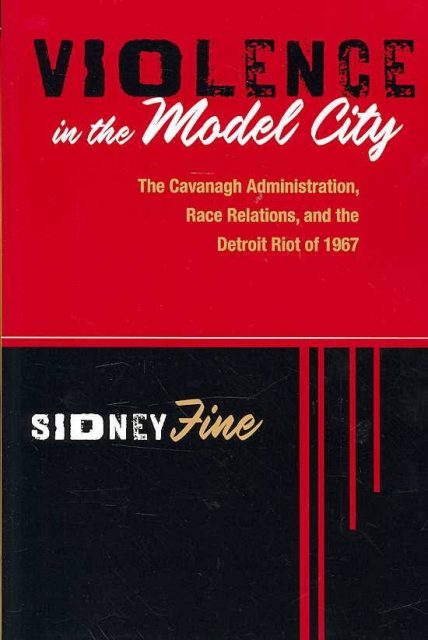 He “interviewed a substantial number of persons who had been involved in the disorder; some of these had been arrested and others had not,” according to a study on the administration of criminal justice after the Rebellion in the May 1968 Michigan Law Review, which quoted from several of his interviews. UM emeritus history professor Sidney Fine, in his prodigiously-researched and -documented study Violence in the Model City: The Cavanagh Administration, Race Relations, and the Detroit Riot of 1967 (Ann Arbor: UM, 1989), also quoted from several of Dr. Caplan’s interviews.
He “interviewed a substantial number of persons who had been involved in the disorder; some of these had been arrested and others had not,” according to a study on the administration of criminal justice after the Rebellion in the May 1968 Michigan Law Review, which quoted from several of his interviews. UM emeritus history professor Sidney Fine, in his prodigiously-researched and -documented study Violence in the Model City: The Cavanagh Administration, Race Relations, and the Detroit Riot of 1967 (Ann Arbor: UM, 1989), also quoted from several of Dr. Caplan’s interviews.
According to Professor Fine, they included interviews with four looters, a fire-bomber, the person who allegedly broke the first window in the uprising, the arrestee and one of the owners of the “blind pig,” or after-hours drinking establishment, at 12th Street (now Rosa Parks Boulevard) and Clairmount, the flashpoint of the Rebellion.
Dr. Caplan recorded most of the interviews on audiotape and had his secretary make verbatim transcripts. Respondents were guaranteed confidentiality and anonymity.
STUDIES
Additionally, two weeks after the Rebellion, Dr. Caplan and Dr. John P. Robinson, also of ISR, assisted in writing the questionnaires for a survey of attitudes of 437 African Americans in the affected areas, sponsored by the Detroit Urban League and coordinated by and published in the Detroit Free Press. Later, with Jeffrey M. Paige, a graduate student, he reanalyzed these results for the Kerner Commission, which published their findings in its final report. Dr. Caplan and Paige later collaborated on “A Study of Ghetto Riots,” a noted survey on the “rioters” in the Newark, N. J., and Detroit uprisings, in Scientific American in August 1968.
Editing
In publishing the transcript of Dr. Caplan’s interview, we have retained his rendering of colloquialisms and their contractions, including “’em” and “em” for “them” and “a’” and “a” for “of.” The ellipses (…) are in the original transcripts, as is underscoring for passages that were unclear. We have broken up long paragraphs, added punctuation only when it appeared necessary for clarity, silently corrected obvious misspellings, and inserted clarifying information within [brackets]. We have also added topical subheadings. Finally, out of respect for the sensibilities of our readers, we have replaced most of the letters of offensive words with hyphens.
(VOD: for the sake of space, please apply Mr. Lee’s statement above to this section and the following two sections of this interview.)
ANONYMOUS ARRESTEE INTERVIEW Sunday morning, July 23, 1967
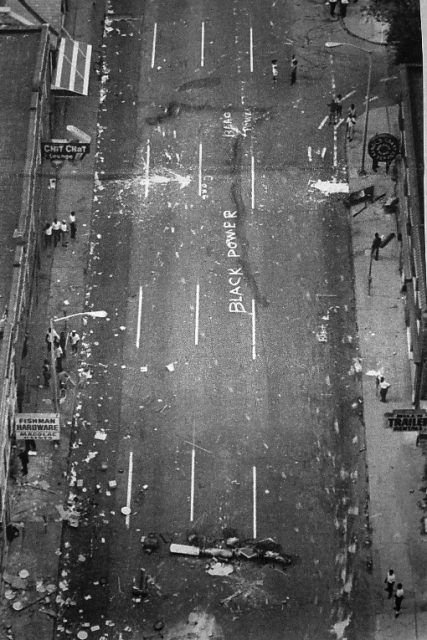
The underlying reason for the rebellion
C:The thing I want to know most about is what happened to you from the moment you got picked up, why you got picked up, — up until the time you were released.
W:That ain’t gonna be hard. But you’re still whitey.
C:You told me that the first day you had gotten involved in things that maybe the police could have arrested you for, but that when you got picked up, — you got picked up when you went down to buy a newspaper. Why don’t you tell me something about that. You told me that you were carrying on in the streets and then you went home and you rested and went to sleep. OK, let’s take it from then on.
W:I went home and I went to bed; I was tired. And yet I was disgusted, was the word, you know, because … I was talking with John ______ [U. S. Rep. John Conyers, Jr.] and we was trying to find an inspector to stop the riot, you know, to get the police out of the area, you know, because they shouldn’t ’a been down there.
C:Why shouldn’t they have been down there?
W:Because the riot was over. You see all them ole’ peckerwoods down there, you know, just to show off their guns and their rifles, you know, they say they’re Government, they had to do that you see. Whiteys, they always do that, they got…
C:The riot was over…?
W:The riot was over at 8 o’clock in the morning. Most people in the neighborhood they didn’t know nothing about it.
C:Sunday morning.
W:Sunday morning, yeah.
Antagonized
C:And the people in the neighborhood were surprised to see the police there?
W:No, they got hip. I mean, after, you know, most of ’em came out on the street just to see what was goin’ on, you know. Many of ’em had heard what happened. So they saw all them peckerwood cops out there with their shotguns and funny old grins on their faces, you know, like they goin’ to get somebody, you see.
C:Don’t you think they deserved to be there, to protect the buildings?
W:No, man, what already happened was over and done with. They shoulda let them people just have that, because that was gonna happen anyway. If they was smart they’da kept their butt out of it and said well, you know, chalk it on down as a loss. No, they had to come in and antagonize the people, see, and they went on and went on. And then is when this deal came in, man, we got together.
C:Did they antagonize the people simply by being there Sunday morning?
W:You know what antagonized ‘em? Those blue uniforms and those guns, specially those guns.
C:What kind of guns?
W:Rifles, looked like. They looked like elephant guns, man, like you washunting some wild beasts or something.
C:They were shotguns.
W:They were riot guns. They were one, single-shot shotguns.
C:Was it just their presence or did they also talk to you?
Accosted
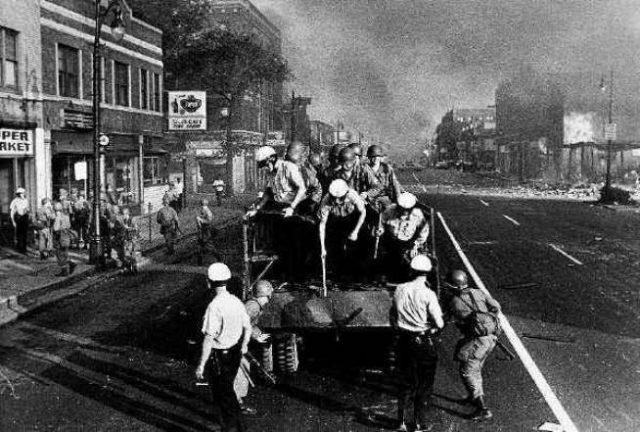
Police get ready to raid community.
W:No they don’t say nothing to you man, they got that little arrogant smirk on their faces. Make you want to kick ’em in the ass. I talked to John Connors [Conyers] that morning, he was over to Grace [Episcopal] Church [at 12th Street and Virginia Park] you know. We were out trying to find an inspector, you know, so we could talk to the dude. And… to get the police out of the area because more people were coming out and gathering around, you see. If the police wasn’t there everybody’d stayed home; nobody would a came on the street, you know. So I was talking to this one old peckerwood cop, and I asked him where could I find the inspector. And he said he didn’t know, you know. He said he was around here someplace, and he pointed out a few directions, you know. All of a sudden this old peckerwood jumped from behind there with his gun and threw it in my chest. That was it. I asked him, say, man, why you do that? And he say, git back, git back off the sidewalk. And I said f— you man, I’ll kill you mother-f—– ass, you know. And he smirked and I says to the other guy, I said, man why he do that, did you see that s— he just pulled? And he looked at me like he couldn’t do nothing, like he had to go along with it, you know. So I said, f— him. I went home and went to sleep man. Got in bed.
C:What time was this?
W:It must have been about … it had to be about 10 o’clock in the morning.
C:Sunday morning.
‘Let it burn’
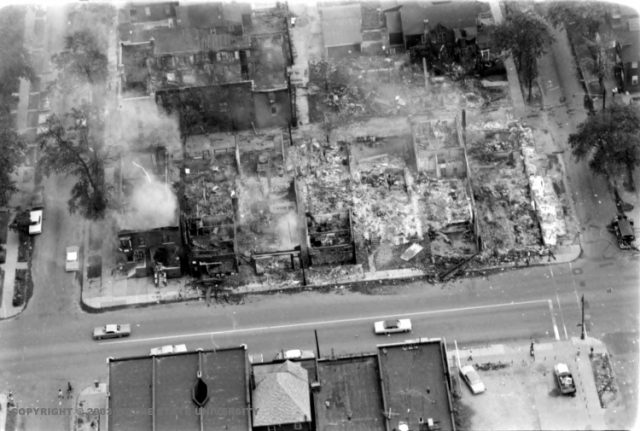
Homes and businesses burning on Linwood and 12th.
W:Yeah, it had to be about ten o’clock. And I was tired. I was beat. I went and got into bed, and I was sleeping. Then all of a sudden my brother come in and woke me up. He said, man the house is on fire. And everybody was taking stuff out of the pad, and there wasn’t nothing I could do but get my butt on out too. So we was pulling stuff out of the house as fast as we could, across the street, piling up the churchyard. And so we sit there and we watch the house burn down. There wasn’t nothing we could do.
C:Your own house?
W:Yeah, and the fire department came you know. They put it out one time, and it started back up and the cat said, let it burn. So they let it burn.
C:Who said that? W:The fire chief … whoever was on the truck, said let it burn.
C:How do you feel about that?
W:When he say let it burn? I don’t know, I can’t say, you know. The words I did say was, that punk coulda put the fire out, you know. They could have made sure it was out.
C:How did you feel about your own house burning down?
W:Well, I mean, look, figure it like this: you know, you can’t ask me that question because I live out in the street anyway, you know. I just recently came back home. I live around, I live from house to house, a floater. It don’t make no difference, you know. I just felt bad because all my books got burned up, if you want to know the truth. I really felt bad about that. And I had just got through working so hard cleaning the place up. And it was all burnt up man. I felt bad about, you know, the house going, but I felt worse about losing my books. Cause this is something you just can’t get, you know, I collected these things, you know. That was just something that happened.
An old man
But anyway we’s standing out there and so this old man was coming across the street … he was dragging his house across the street. And here come them old peckerwoods down the street like they’re in the army or somethin’ you know, they’re lined across the street. And this old man … now dig this. He grabbed his worldly belongings out across the street. He ain’t riotin’. The riot’s down the street. They done blocked the street off. And they’re going to butt him in the head with their guns, the butt of their gun, and busted the guy’s head.
Now if I’d had a gun I’d a shot the hell out of that man. I’d a killed him dead. Now that was unnecessary. Oh, you should have seen the look on their faces when they do that. They knocked the old man and they going to get big about it. I kill that punk if I see him again. There’s a whole lot of cops I’m gonna kill. I am. If they f— with me I’m gonna kill em. They, you know, they just get arrogant. They bad.
‘I would have killed him’
C:Why do you think they hit the old man?
W:Oh, a man got to demonstrate his power, you know. The cops said to him, you know, get out of the way. The man was dragging his furniture; he couldn’t move no faster than that. Just because he didn’t obey his order I guess, that was the thing. He wasn’t gonna take nothing from a nigger. That was probably what was in his bag. But he didn’t have no reason, you know, to hit that man. You see, he could have walked on past him. But they were clearing the street so the fire engines could get through. But this one man was on maybe one-quarter of the street. He’s on the other side and the fire engines could have gotten through. But they come down there buttin’ everybody in the head. If somebody would have shot the man I couldn’t blame them. I’d a blew his damn brains out too if he’d a hit me in the head.
And we had a shotgun. We took it when we left the house. We had a shotgun and we had a pistol. My old man had the pistol down here in his belt and we had the shotgun rolled up in a mattress, you see because they was taking guns away from everybody. Man if I could have got to that gun I’d a blew his brains out. I swear I would have killed him dead and wouldn’t have cared less; I got no compunction for people like that. After awhile it got real scared, everything was up in flames, you know. Dark outside and these cops running around and shooting, losing their damn minds. So the family had to split up you know. The old man, he went someplace. And my brothers went someplace. And I went someplace. I went to this friend’s house, you know. I was gone. My mind was blown after watching the house burn down. I was finished, you know, lost everything. So I just went over there and I spent the night, you know.
C:Sunday night?
Monday, July 24, 1967
“Police Riot”
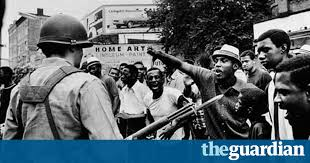
Youths confront police: Out of our community!
W:Sunday night, yeah. I went over there and spent the night. The next morning … I wanted to know what happened, you know, or what the paper was gonna write. That’s what my main interest was, what they were gonna write about something, you know. I wanted to see. I just wanted to see if they tell a lie, cause I heard over the TV. One of the cats said … when I first heard it on the first report, he said it was a hot day and it was a race riot. Them were damn lies. That morning it was cool out. Three o’clock in the morning man, how is it gonna be hot? Will you tell me that? That’s a lot of bull. He said it was race riot. Man there wasn’t no race riot. It was a long ways from a race riot. It was a police riot if anything.
Arrested
OK, so I left this friend’s house and I was goin down to get me a newspaper you know. I was walking down the street. So I gets to the newspaper stand and no newspapers in the stand. OK? Here come the boys with their fleet of cars like, like a band of wild animals, you know, and they circled all around the block and they busting everybody on the street you know. …you know they’s chasing everybody on the street. So I was standing on the corner and some kids come running past me and all of a sudden these cats jumped out of their car and they ran up to this door and they grabbed all the people on the street. And they said, get in the car.
And I said, man I ain’t doin nothing. And the guy said, get your … well, get your mother-f—— a– in that car or I’ll blow your god— head off man. I didn’t do nothing. I couldn’t say nothing then. The man had me. There wasn’t nothing I could do. With a gun pointing at my nose, uh uh, I wasn’t going to try it. And then we was sittin’ in the car and they handcuffed us man, this is what really got you. Two of these big mother f—— sitting beside me, one sittin’ on one side and the other sittin’ on the other side, and they gonna put hand-cuffs on me, behind me. And I got to sit back on them handcuffs. Have you ever had police handcuffs on you? They cut your skin.
‘It wasn’t worth a human life’
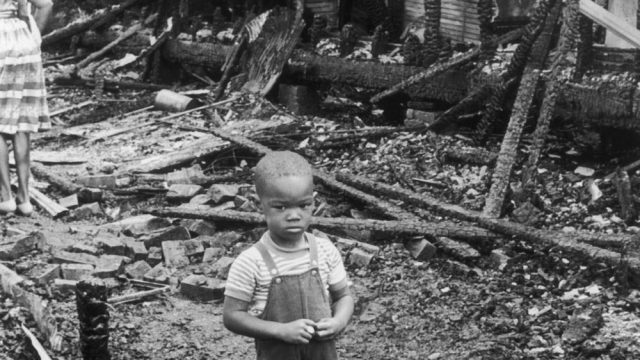
Child in midst of ruins of rebellion for self-determination.
They’s some human [inhuman?] f——. OK, we stood there waiting … those stupid cops. He ran up to this window with his shotgun. Evidently there must have been some boys in the store and I heard him say (these are his exact words, so help me, he said) “bring your god— a– out or I’ll blow your mother f—— head off.”
You know, and these little kids come out. Just little kids you know. And they said, lay down on the ground. Man, see, that s— wasn’t necessary. Talking about lay down on the ground. He don’t have to tell nobody to lay down on no ground. They’s scared. OK, I heard one. This one kid, when I was sitting in the car, they were going to take me to the hoosegow, they stopped this lady.
And she was trying to tell them, she says look I’m under a doctor’s care, you know. I can’t be going to no jail or nothing. I’m not doing nothing out here. And he said, come on lady, you got to go too. Lay down on the ground. I could pop those mother f—— every time I think about this s—. There wasn’t no use for all that, telling people to lay down on the ground. For what? First of all, maybe it was a riot. That’s true. But there wasn’t no riot down on that end.
All these people was doing was looting. And as far as I am concerned, that old bull s— that them people took — that merchandise, uh uh, it wasn’t worth nobody’s life. It wasn’t worth a human life to anybody. You see.
‘I don’t blame them’
C:Who was taking merchandise?
W:Little kids … mostly little kids. Grown folks, you know, they’s [they’d?] run in the stores and snatch something and pull up. But you didn’t see too many of them. It was mostly little kids, you know. And they was threatening them with these guns, scaring them half to death.
C:What kind of things were the kids taking?
W:You know, anything, stuff like popcorn, whiskey, things they could sell you know. Jewelry, clothes, it was nothing, you know, nobody … nothing nobody would mess with. Drugs in the drugstore, you know, narcotics, nobody would mess with them things. People wasn’t thinking, you see. Somebody could of got rich, got stone rich, you know. But they wasn’t thinking about that. These little kids just saw something and they wanted it, and took it. And I don’t blame them.
Police garage
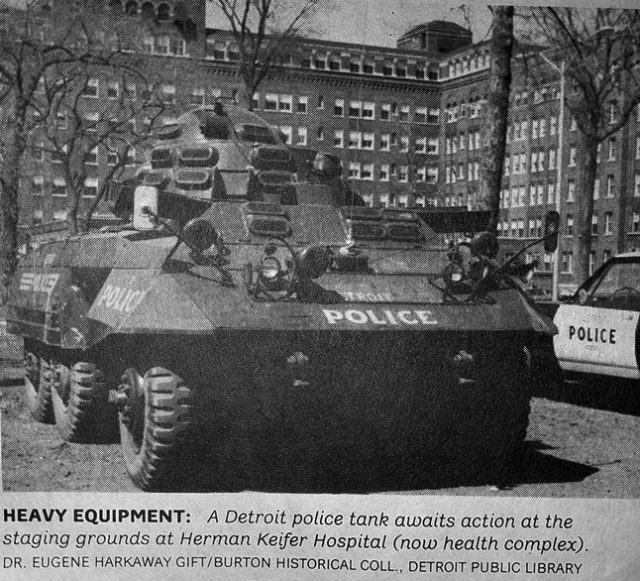 OK, so we was going to the police station. They starts taking us down. We got to the joint and we drove in this big parking lot. Man they got walls built around all four sides. I steps in there and there’s an army tank there, fronting [several words inadvertently cropped off last line of original page] you know. All the police around it in a big circle, giggling and laughing, twiddling their guns you know, like you see in the cowboy movies. And so they took us out of the car.
OK, so we was going to the police station. They starts taking us down. We got to the joint and we drove in this big parking lot. Man they got walls built around all four sides. I steps in there and there’s an army tank there, fronting [several words inadvertently cropped off last line of original page] you know. All the police around it in a big circle, giggling and laughing, twiddling their guns you know, like you see in the cowboy movies. And so they took us out of the car.
C: Was that the National Guard?
W: Yeah, the tank was, National Guard. Facing this garage was a big gun trained on the door. So they take us out, take us out of the car and yank on us and put us in this garage with all these other people. And get this. They park their cars there you know, grease all over the floor, water running from the sewer. It had a hose in it so we all could drink some water and wetting up half the floor so nobody can’t lay down, or else you don’t get no water. You die of thirst. They could care less. You know.
OK, so they put me in there. OK, I been in jail before for some old traffic tickets or some old bulls—, you know. But I’ve never been arrested or convicted of anything. But I’ve been in jail before. At first I thought I’d be out, you know, cause they didn’t have nothing on me, I didn’t do nothing. But I got fooled. Did I get fooled. Wasn’t no sense in having no hope. You can forget that word. You might as well forget it, there wasn’t no hope. You was in prison and forget it. You know, you was sentenced, tried and convicted. You was going to be there for a while.
‘He was real nice’
So OK we all sit around and we talk, you know, we try and find out what’s going on. We just sit there for a few hours and then this man come and call me out of the garage. And he take me to the room they’re going to interrogate me in. He was real nice, let me tell you, he was so nice that he tried to get me to say things that I didn’t do. He was going to use simple psychology on me.
So he gets me in there and he said … he tells me, you’re in bad trouble. I said, for what? What did I do? What’s the charge against me? He said, breaking without entering. I said, man what did I break into? And he said, didn’t you break into that store? And I said, hell no man, I was just standing on the corner. He asked for my name and all that you know.
C:Was he an officer?
W:He was a detective, a punk.
C:In uniform?
W:No, he wasn’t in no uniform. He might have been a newspaperman for all I know, trying to sell subscriptions. I don’t know.
Police behavior
C:When the police arrested you, and they were on the streets, did they wear their badges?
W:No, they took their badges off. All their badges was gone. You know, they talk about all the snipers that was going to shoot at you. That’s why they killed the people, so they wouldn’t get their number. They could knock you in the head. Nearly everybody that came there in jail had a cut in their head or something wrong with them, that the police had did to them. It’s a fact. And the people they locked up. The police jabbed them in the back with those guns, busted them in here with those sticks, some of them.
Man, one guy was in there for three days and he had a busted jaw. Three days — and he couldn’t talk. His mouth was busted and they knew it. And they’d say, yeah we’ll get you to the hospital. They didn’t care if the man died.
‘Something in common’

Gerneric photo: police force woman to strip.
Anyway this guy gets me in there. He asks me my name and all this you know. And this was one thing that was really an added attraction. He asked me what religion I was, you know, and I said Catholic. He said, you are? And I said, yeah. And he got sort of happy you know, like we had something in common.
He asked me something about do I make some kind of a sacrifice or something — penance. And I said, no. And he got mad. He said, don’t you believe in your faith? Don’t you practice it? And I said, yeah man when I get a chance. He said, didn’t you go to church yesterday? And I said no. And he got red in the face.
And I said, oh, oh, this cat must be real religious, you know. I was going to play his game you know. I got real Uncle Tomish with him, you know. Yessuh, nossuh, you know. He liked this. He really dug it you know. And he threw his hands up and he says, (he was going to let me go for a minute, I thought, you know). And the cat said, no I can’t do that. Get your hands back in there.
What he was trying to do was try to get me to admit that I did something when I really didn’t. And he was playing up to me, telling me, you’re more intelligent than most Negroes I’ve spoke to, you know. And I think you should tell me what you’ve done. I could help you. That man didn’t want to help me, he wanted to send me to jail. Cause what he did — I had a brand new I.D. bracelet on my arm. That man took my I.D. bracelet and says I stole it.
And get this. He called this other guy from the teletype and he said, hey Sam, dude. (I remember his name). He said, hey Sam. Sam was an ugly dude. He was so brutal looking. I’ve seen him before someplace. And so he called Sam over and he said, say, Sam, this I.D. bracelet was taken out of someone’s store. And Sam said yeah. And I said, you must be a damn fool, Sam. How can you identify any I.D. bracelet from any other, you know? And he said, we going to use this evidence against you.
And I said, make your song, you know. And he took me back into the joint you know. So I was in there sitting down with the rest of the clan. Oh man, I tell you, the garage was about the size of a ping-pong room. And there was something like 200 people stuck in there.
C:Men and women?
W:There wasn’t any women in there.
C:Children?
W:Naw, there was some young boys in there. And they didn’t weed them out until … some of the boys went to court and some of them just stayed there you know. But what they did was put the women in the inside cell. They filled all the women up in the inside cell and the men in the garage. And these women … well, I’ll tell you about that before you go home though. So, we was sitting there in the garage…
C:How many?
W:About 200 of us.
C:How long was the garage?
W:Roughly speaking … I couldn’t tell you feet, I really couldn’t, but it’s a very small thing. It’s no bigger than this whole space including this office you know. About that big. Not even that wide.
C:A two-car garage?
W:About a two-car garage, yeah. About 200 people in there and they had a tank at each end of it, with big doors. That was stupid. That was one of the stupidest things they could have done. That was stupid. What did they need them tanks for? (Continued next issue)
We would like to thank the Lyndon Baines Johnson Library and Museum, Austin, Tex., for Dr. Caplan’s interview; the Burton Historical Collection of the Detroit Public Library and The Detroit News for the photographs; and Dr. Caplan for permission to publish his interview and for kindly supplying helpful background to it. — PL. Copyright © 2007 by Paul Lee
Rare testimonies and reports on the ’67 Detroit Rebellion
INTERVIEW
Introduced and edited by Paul Lee Pt. 6
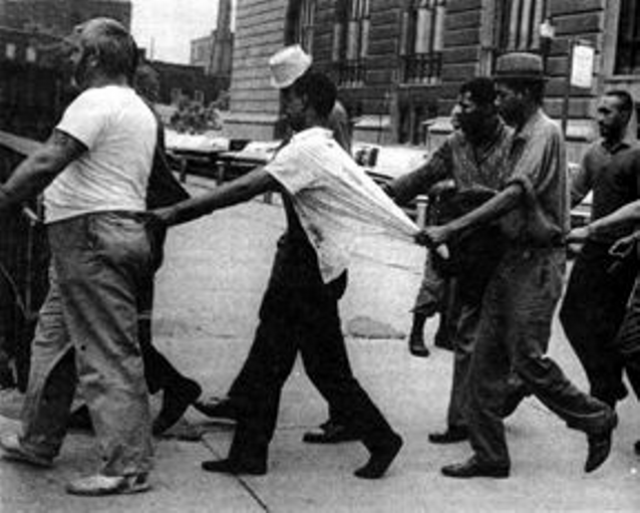
PROCESSION’: White and black male prisoners being led by National Guardsmen into the Wayne County Jail on a forced march reminiscent of the slave coffles of centuries before. Detroit Police Department headquarters at 1300 Beaubien is in the background. “The picture was taken on Monday or Tuesday,” July 24 or July 25, 1967, photographer J. Bruce Baumann recalled. “I remember going to the jail to see … how many people were being arrested. The numbers were even higher than I expected. The cells were so crowded that most of the people had to stand. I smoked cigars in those days, and an inmate asked me for one. I gave him one, and when I turned around he was already smoking it. … Giving him tobacco was probably illegal, but seemed like a decent thing to do.” J. BRUCE BAUMANN PHOTO
This week, as part of our extended commemoration of the 40th anniversary of the July 1967 Detroit Rebellion, The Michigan Citizen continues the verbatim transcript of a gripping interview with an anonymous “arrestee” by University of Michigan sociologist Dr. Nathan S. Caplan, which was conducted on Nov. 4, 1967. A copy of the interview, only brief excerpts of which have appeared in print before, was found in the records of President Lyndon B. Johnson’s National Advisory Commission on Civil Disorders, or Kerner Commission, at the LBJ Library and Museum in Austin, Tex.
The arrestee, an intelligent, sensitive and street-hardened young Black man who lived near the densely-populated 12th Street (now Rosa Parks Boulevard) and Clairmount area, the flashpoint of the Rebellion, was promised confidentially and anonymity by Dr. Caplan. In achingly candid and often raw language, he describes the abuses suffered by him and hundreds of others — mostly African American boys and men, but also black women — at the hands of the police, the military and the courts during and followingthe Rebellion.
The result is a powerful account of the depth of the institutionalized white racism and hysteria on the part of the local, county and federal governments during that epochal period of social upheaval. In this part, the arrestee continues his narration of the gruesome conditions in an overcrowded jail in a police garage, where he was incarcerated on Monday, July 24, 1967.
ANONYMOUS ARRESTEE INTERVIEW (cont.) ‘
We’s animals’
Caplan: What did you talk about?
Witness: We talked about … we say man when we getting out of here. That’s what we talked about. When they gonna call our name? That’s what we was talking about. That’s what you always talk about when you get in jail. When they gonna call our name? Sometimes we don’t get called. You talk about the judge and how much time you’re gonna get. That’s what you talk about. You’re too depressed to talk about anything, too worried about when you’re gonna get out of here, if you ever gonna get out. That’s always a fear.
So we stayed there. Some of us talked you know, scrounged for cigarette butts, passing smokes around. Then about … I guess it must have been ten o’clock cause it was dark outside, this old fool … an old drunk man, he gonna get up and he gonna walk out of the garage now. I thought that was silly. He was drunk though, I can understand it. But that cat walked out of the garage. And they slammed those doors down and all of a sudden you heard all this shooting and that was it for me.
That’s when I blew my mind and my cool. I jumped back in the corner with the rest of them people. We was never so scared in all our life. That’s the first time we’d actually heard any gun shooting close to us.
C: You thought he got killed?
W: We thought he got killed, but he didn’t. When they threw him back in there … and they literally threw him back in, he had gunshot wounds all across his chest and his back. You could see where the guns had gone across him and blood was coming out. And they just threw him back in there you know. When this happened, they raised up the front garage, and here come all these peckerwoods with their guns and bayonets. They come and hit people over the head. One man walked out. They didn’t have to do that. That was…
C: Unnecessary.
W: No it was ignorant, disgustingly stupid people. Sometimes I wonder, how stupid can anybody be? Now who gonna be fool enough to break out with all them tanks out there and all that artillery there? They must think we some dumb people. They don’t consider us human, no doubt. We’s animals you see. We got to be tamed, our spirits got to be broken. That’s the way they must feel or they wouldn’t have did that. They would have treated us like human beings. Well, anyway, next day rolls around. Nobody knows what’s going on. Nobody knows nothing cause nobody’ll tell nothing.
Tuesday, July 25, 1967
C: This is Tuesday.
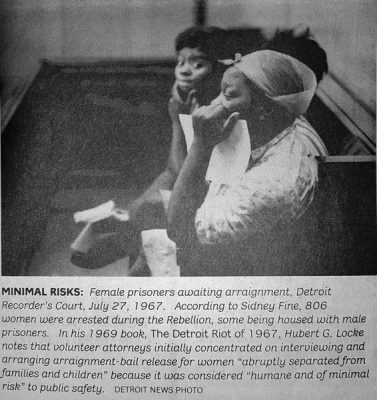 W: This is Tuesday. We was sitting outside in the garage door, and … all day we watch the police bring people in. They bring people in handcuffed, beating them in the head and kicking them and so forth. This one particular instance aroused everybody in the garage.
W: This is Tuesday. We was sitting outside in the garage door, and … all day we watch the police bring people in. They bring people in handcuffed, beating them in the head and kicking them and so forth. This one particular instance aroused everybody in the garage.
There was this girl they had and this big policeman. This was a rotten m—-r-f—–. She turned to the garage and, you know, this was a happening thing that was happening to us. And he turned around and kicked her in the butt. Look, I tell you, right here now. I don’t give a damn what color a woman is, I don’t care — you respect her as a woman. I tell you, I don’t want to see that again. I see a peckerwood kick a negro woman again, I’ll kill him, so help me God, I’ll kill him.
He thought he was so bad. If I’da gone out and shot his head off, I don’t care. I require that for any woman. I don’t care what damn color she is. You just don’t do that. I don’t care what the crisis is, you just don’t do it. Anytime you put yourself over a woman, OK, you all supreme, you’re a dictator, then you’re pure, you’re the immaculate conception. But you do that s— one more time and I’ll kill you.
I think all of us felt that way. And we yelled out to him, hey, what you doing? He snickered back at us. And we couldn’t do nothing. But if we could of, we’d a ate him up. That’s how cops get the s— beat out of em, pull a show off like that. So later on … we was in there for about … it was three days before we ate.
So you know we was … we were gone … we was starving, you right. Oh there was water man. I tell you I felt, after that night when they was shooting, I started praying to God. I started praying to the Lord, help me now. That’s the only one I got to rely on, man. I couldn’t call no lawyer. I couldn’t make no telephone calls. They walk up to me and they say, nobody is making no telephone calls. You’re not permitted to. So we didn’t make no telephone call.
So we sat there … we dug them cats bring people in each and every day you know. And I know they had a little Civil Defense come in and piled up all this stuff and take it back. And if they caught a sniper, man, they beat him all the way in the station … if they caught anybody shooting, they beat him all the way in the station. Soon as they got a narcotic [user?], they beat him long side of his head.
As I say everybody had something up side of the head, except me. I was underneath everybody, I wasn’t about to get hit in my head. One thing, I can tell when a man getting mad or something you know, and just maneuver enough to get away from him. Cause you can tell what they about to do. So what I did, I just sit there with the rest of them, just praying, you know, feeling lost and everything. They got this bus and they says they gonna take us downtown. And so we got on the bus you know and we was on there about…
DSR jail
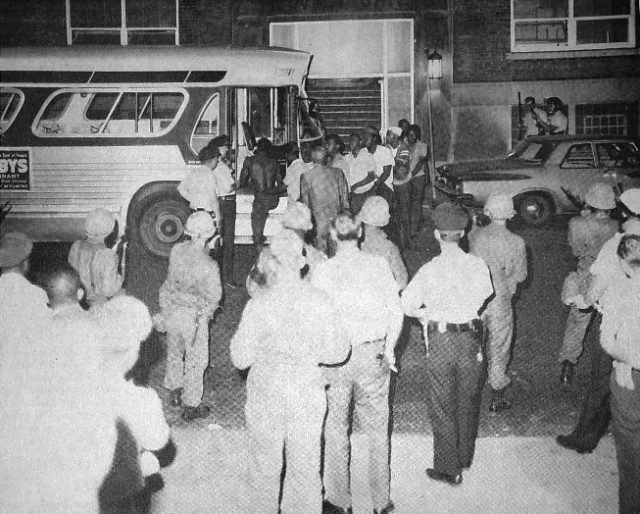
JAILS ON WHEELS: Prisoners being transferred from Wayne County Jail under heavy guard by police and National Guardsmen July 25, 1967. After the local jails became overcrowded, prisoners were quartered under guard on seven hot DSR buses like this one for as long as 24 hours. Water was served out of a bucket and prisoners were compelled to relieve themselves alongside the buses. DETROIT NEWS PHOTO
C: What kind of bus?
W: It was a DSR [Department of Street Railways] bus.
C: How many on?
W: All the seats filled up on the bus, you have to find out the average of what they have on there, you know, how many seats they have, how many people it seats, and then you can find out, you know, how many people were on the bus. But it was filled up. And we sat out there in the parking lot, and we hadn’t eaten, you know, for three days, and the bus was out in the hot, scorching sun, you know. It was hot outside. And with this bus facing the sun, it beat down. They had the doors closed, you know. You couldn’t … you couldn’t open the windows man! They wouldn’t let you open the windows … security reasons I believe. They’s scared some nigger gonna try to get away …with all them guns pointin’ in his face.
C: Where were the police?
W: You mean where were the National Guard? The police had left us alone you see. You could see me, cause they moved the bus in the other end of the parking lot. And there we sat. You could see the police but all the National Guards was all around, pointing those guns. Some of those little, young punks. Man, they ought to take the Army and cram it … anything that has to do with it. They’s sitting out there like we gonna run away or somethin. That’s so … I think there’s some stupid people, dopey people.
So we sat there, and later on they bring us some water in a bucket. I thought that was real humane. That water taste like it was moldy too, like bread. And you had your one cup of water, you could dip your hand in and get some water in the cup. After you got through dipping for a few times, the water was so dirty there wasn’t no sense in drinking it. But we drunk it anyway cause we’s thirsty as hell. Sitting on the bus a few times I almost passed out from hunger probably and the heat. I just had a tough time just trying to keep myself together … it was hard. Cause it was so easy … it was easy to let go you know. Later on in the day they brought us some sandwiches in a box.
Wednesday, July 26, 1967
C: This was Wednesday?
W: Yeah, Wednesday. It was the third day. You know, they gave us the sandwiches and that was all we get. And the only thing that did … the sandwiches was to antagonize you and make you want more. But you couldn’t get more and that was the depressing thing man. You was right out … you know … you was free … you was still on the street, but you was in some compound you know. I mean you could just touch it but you … I mean … I don’t want to say this man.
But they gave you a little bit to make you want more. And when you couldn’t get more … you knew you couldn’t get more … it ate at you. Dehumanize you … that was the process. So we stayed on this bus until we got pretty damn sore. We stayed on it until late that afternoon … it was five o’clock or something. So here come the boys on…
‘Damn regulations’
C: What’d you do for a bathroom, what did you do for a toilet?
W: Well one thing about the toilet what you did and I think this is really pitiful. You had to come outside the bus … and the National Guard would let you out one at a time … and you stand and take a leak on the side of the bus, facing the highway.
There was this one woman on the bus. I don’t know how she got there with us. But, she had to go to the bathroom. And they could of walked her over there to let that woman use the bathroom in the station. They told that woman she had to use the bathroom outside with the rest of us, and they would turn their heads. But god—, the whole city can look on. I think that was really … man, what’s wrong with these … they sick or something?
It wouldn’t have hurt one of them boys to walk that woman back to the bathroom. Sorry, regulations … do it. That’s the trouble. You got too many damn regulations that people can’t meet up to. That was disgusting. So she stayed there with us … she didn’t use the bathroom. She didn’t bother and I don’t blame her. Give her an alternative like that. You might as well say blow your brains out, or eat acid. How’s that?
Procession
S
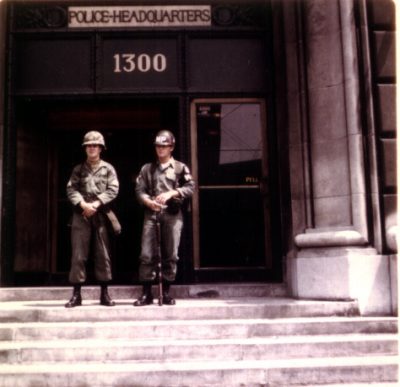
DPD headquarters, 1300 Beaubien
o they got us together in a little caravan and we had a fleet of buses go downtown to the 13th precinct … 1300 B_______ [Beaubien, Detroit Police Department headquarters], or was that the first precinct? I never could get it straight. Oh man, they had a recession [procession?] for us that was out of sight. They had a bunch of pronies (?) [cronies?] standing all around with shotguns, always lined up halfway down the block.
This old man pulled up and he said, look, don’t nobody try to run because we’ll shoot you. And when you leave here you put your hands on each other’s belt and you run in a line, and I mean move fast, and don’t stop for anything. What the hell we going to do with that fleet out there anyway? Where we gonna go to? And the man had the camera out there taking newsreels and everything else. Man, look, I didn’t do nothing, see. And the cat didn’t have no reason to be doing all that to me … why can’t I just walk in? No, they gotta make us act like we criminals or something, hardened criminals. I betcha what, I’m a hardened criminal now. I know that.
‘So help me God’
C: Would you ever let them arrest you again?
W: Would I ever let them arrest me again? Hell no. I swore that one time before, see, when they pulled something off once before on me and I got in a fight with a police officer. He hit me and I jumped on his head and tried to kill him. He kicked my butt but I tried to kill him.
And I tell you what. Just like [I] told them people at the draft board. They come f— me I’m gonna kill em. I mean the police and them people too. I’m gonna kill em. Just like that. They going to kill me or I’m gonna kill them. See, cause they ain’t got nothing to do with me. I’m not breaking no laws, I’m trying to live and mind my own business. And they gonna force something on me that don’t even apply to me.
Because I don’t get the respect that I should get from the law. And don’t ask me to do something for you, join your armed services, be polite to your police. They don’t do it to me. And the next one, so help me God, he puts his hand on me, and the people from the Civil Service, whatever they call em … whatever they call them … the f——, the FBI or CIA agents that come down here and put their hands on me, I’m going to kill him.
Tell me to come over here … I’ll kick his a–. I’ll tell him to come over with me and we’ll go right off to the promised land together. I ain’t going and I mean that.
Another police garage
So man they just run us all up in there. We had to run down through [the] precinct … this is it boy. They ran us down to this big garage this time. And every time we get to this one man he … one, two, three niggers, you know, and send em all in, you know. He hit em all on the back. They go in. So there we were, one big happy family. They thought they were dealing with the masses but they were dealing with individuals.
And it’s a hell of a thing to crowd a bunch of individuals together and watch their relationships with one another, and their actions. They had old men in there. They had sick men. They had men sick physically, psychologically sick. They had young people that shouldn’t a been there. They should a been in juvenile, but they didn’t look carefully enough.
Now, the young people, they could of took it, they could of stood it just for a little while longer. But there was no need to have those old men in there. Cause I don’t believe in it, see.
C: (inaudible)
W: They didn’t have any women in there — they separated them you know. I don’t know, from some of the stories I heard they weren’t treating them no … not too much better. I doubt if they were. We stayed in there for a couple of days … no, a day and a half before we ate anything And this time … the same thing as in the other garage you know … water running through the place so you could drink but that was wetting up the floor all the time.
When we used the lavatory we had to use one of the corners. We selected the corner we were gonna use and that got pretty bad. When we finally got any kind of response and cooperation from these people, it was when we formed what they called a nigger session, see, we had to get nice. We all sat down on the floor and we all talked nice to the people. We formed this little committee and got orderly like they wanted to see us do. But they still didn’t treat us any better. They said they’d clean up the mess and they’d give us proper medical care like we was negotiating in a concentration camp man. What kind of jive is that?
C: …sick.
‘Like Hitler did the Jews’
W: OK, then it came time around when they fed us you know. The cat threw the sandwiches in the door. They opened the door — get back — and they threw the sandwiches in a box. You know what that caused don’t you? People were in there … three or four days, hadn’t eaten. That was a new one. There wasn’t no need for that, they could have found an orderly [way?] to give everybody something.
Just two boxes — stand aside — and everybody run for those boxes. That was it. Some people still didn’t eat for three or four days. OK? So they finally decided to take our sick out and come in and clean up the floor. So they all pointed their guns out the garage window, man you shoulda saw it. Them cats were so stupid.
And they marched their battalion in — everybody up against the wall. So we all backed up against the wall — you know like Hitler did the Jews. And the Germans came in the concentration camp and everybody was backed up in one line or something. And they said — a man stood off and he said, bring the sick out. Bring em out, bring em out, sit them right here. Now get back, get back.
C: Did they have guns on you?
W: Yeah, they had guns on us man. And we was all locked up. Now, that was … I thought that was stupid. That was sick. What could we have done? They already had guns pointed out the window. We saw those guns. That was stupid. There was no need for those guns. There was need for a little kindness if any damn thing. That just angers us and made us bitter.
So they took our sick out and they cleaned up the mess. Yeah, they gave us some kind of assistance … they gave us a roll of toilet paper. And … we’s all set, you know, really set man. So they did find another way to give people things to eat. They hand it to you through bars. They had us line up finally and they hand it through bars. One sandwich you know … a rat couldn’t live off that. You beat somebody out of a place in line for a second sandwich.
You couldn’t help it man, you was forced to live like an animal. Nothing to it. Then I learned to think like an animal and feel like an animal — and was dirty enough to be an animal. All I knew what to do was to act on instinct that’s all. I saw food — I reacted and I ran for it, fought for it just like anybody else — anybody else.
Mayor’s visit
Then Mister, or Mayor [Jerome P.] Cavanaugh [Cavanagh] — the Honorable Major Cavanaugh — he came into the outside of the station there. Everybody ran through the gate and they called him, called him to come and say something to the people [about] what the hell’s going on. You know, why we kept here without word or something like that. We wanted to know who the hell we are and what we doing here.
And so he ignored us and got in his little Mustang and drove off. If I’d a had a brick, I’d a knocked his god— brains out. Man, I wanted to know what was happening to me and wouldn’t nobody tell me. So I just didn’t know. I was lost. You say, you lose your identity, isn’t that the word?
Dungeon
So finally they took us upstairs to the cells. They’d line us up and took us up three at a time. Put our hands over our head and the same old bulls— with the guns, poking your back and in there. And then they moved us up to the little room there … had about 100 people in the room, room no more than 2 x 8, or was it 12 x 8? And there you live for exactly three days. You stayed in there. And there was everything going on in there.
Nobody could sleep because there was no room to lay down. If you laid down you laid down on top of somebody. It was cold … the floor was cold. You didn’t have no cover or nothing. It was this horrible s— … all people crowded up together … people smoking … it was just like a dungeon you know. It was just like a dungeon, that’s all. And you just lived like that. The only [way] we coulda stood it was we started joking, you know, cracking jokes, you know, just getting along and united with ourselves. That’s the only way we could get along. And kinda blowin our heads you know.
Martial law?
So these guys … these guys that take care of the jail, they call them turnkeys, they come running past there and we’d ask the man if we could make a telephone call. And the man said the city was under martial law. It turns out the city never was under martial law.
C: Who was it that said that?
W: One of the officials in the joint, you know, said the city was under martial law. Damn lie, city never was under martial law. If the city was under martial law, they’d take them tommy guns from them police and put them out and the Army woulda been there. Naw, the city wasn’t under martial law. So that how … then they said, you don’t have any constitutional rights when a city is under martial law. So we all assumed the city was under martial law. So that’s the only word we heard — that’s the only word we could get.
No due process
So it come the day for examination. You go in front of “your honor.” I ain’t gonna mention his name, but he’s a prick. So they all lined us up you know in this little courtroom … it’s night-time, and they ran us through the legal procedures, you know. What you call legal, you know, the due process of law. We didn’t get no due process of law, we got railroaded.
The man had folders for everybody. The man ran through the names and said, so-and-so $3000, send him on. So-and-so $2000, send him on. And he didn’t even look up man, didn’t even look up. You didn’t a have a chance to open your mouth and explain nothing. And if you hadda explained something, it wouldn’t a made no difference, they’d a locked you up anyway.
So … look, the thing you could do man, was to shut your mouth and let them do what they wanted to do with you. That’s all you could do. There wasn’t nothing you could do. You ain’t gonna get no advice from nobody — nothing. It was a fix and you might as well face it. And I finally did. When I went up in front of that judge, [I accepted it] cause I realized I wasn’t getting out cause I wasn’t gonna pay no $300 or $3000 or bond to get out.
(Concluded next issue) We would like to thank the LBJ Library and Museum for Dr. Caplan’s interview; J. Bruce Baumann, Dr. Caplan and The Detroit News for the photographs; and Dr. Caplan for permission to publish his interview and for kindly supplying helpful background to it. — PL. Copyright © 2007 by Paul Lee
Rare testimonies and reports on the ’67 Detroit Rebellion
AN ARRESTEE SPEAKS
Introduced and edited by Paul Lee Pt. 7
In this installment of our extended series on the July 23-27, 1967, Detroit Rebellion, the most destructive social uprising in U. S. history up to that point, The Michigan Citizen concludes the verbatim transcript of a riveting interview with an anonymous “arrestee,” conducted on Nov. 4, 1967, by University of Michigan sociologist Dr. Nathan S. Caplan. The 26-page transcript was found in the records of the 11-member National Advisory Commission on Civil Disorders, more popularly known as the Kerner Commission after its chair, Illinois Gov. Otto Kerner, Jr. It was appointed by President Lyndon B. Johnson on the last day of the Detroit Rebellion to uncover the causes of what had become annual urban uprisings since 1964 — the commission counted 164 in the first nine months of 1967 alone — and to make recommendations to prevent or contain future disorders.
Although Dr. Caplan promised confidentiality and anonymity to those whom he interviewed as part of a wide-ranging effort to profile participants in the rebellions — a pledge that he stands by four decades later — it is clear from the transcript that the arrestee was a bright, sensitive and street-wise young black man. In frank and often raw language, his harrowing account begins on the morning of the first day of the Rebellion near its epicenter — the densely populated 12th Street (now Rosa Parks Boulevard) and Clairmount area on Detroit’s near-west side — and winds its way through many of the worst abuses by the police, military and courts.
This included being incarcerated in overcrowded, filthy makeshift detention facilities in two police garages, on a hot city bus and in the “concentration camp,” as he called it, on Belle Isle — known as “Belcatraz” by its inmates after the infamous Alcatraz prison in the San Francisco Bay — as well as being chained hand and foot to a hospital bed. All charges were dropped and he was released on Aug. 8, 1967, nearly three weeks after his arrest.
Hundreds of others, mostly young African Americans like himself, were incarcerated for even longer periods in jails and prisons in five Michigan counties and for the same purpose — to keep them off the streets. As he eloquently testifies, these hysterical measures only inflamed the causes of the uprising and further polarized the already strained relations between black and white Detroiters. This would have far-reaching consequences on the economic, political and social future of the city. In the conclusion of his interview, the arrestee continues his account of the “assembly-line” mass arraignment before an unnamed judge at Detroit’s now-defunct Recorder’s Court.
ANONYMOUS ARRESTEE INTERVIEW (conclusion)
High bail
CAPLAN: Did he ever look up at you?
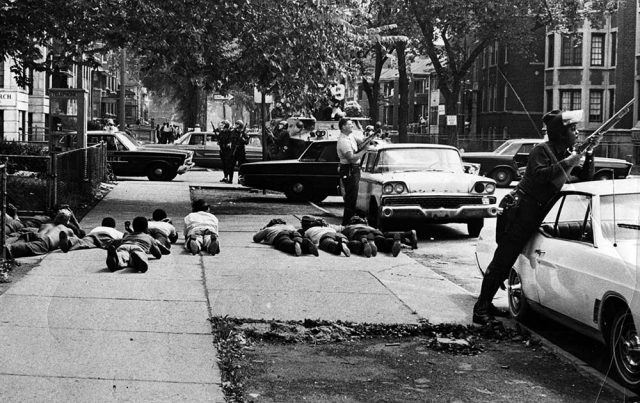
Laid out on the ground.
WITNESS: No, he didn’t look at you. He just looked down at this thing and ripped you on off. C: How did you feel when he said $3000 and then didn’t look up at you? W: When he said $3000 and didn’t look up at me? I wanted to kill him. Cause I wanted to have a chance to explain. I wanted to tell him I just got a job this summer and I was trying to go back to school, you know. And it was the first break I’d had in a long time. And I didn’t get a chance to say it. And because of it I lost my job, locked up in that joint, you know.
And there I was again, like I was last summer, trying to hustle getting back in school. Same thing. You know each year you got to work a little harder and a little harder, and these people don’t care. You tell them and they say, sorry, regulations. Man, damn your regulations! You gotta give somebody a chance to live. We can’t meet up to your regulations and your rules. Because we haven’t got the tools.
You don’t give us anything to work with. That was the thing that really got me when I didn’t have a chance to say, Look, I got a job. I’ll come back man, I ain’t going no place. Look, I’ll face it. If I did something I’m gonna be right back here, you know, but let me go out and hold onto my job. This means a living, and [the chance to] do what I want to do and, you know, have money to do it and to live like somebody. And he said … he didn’t say nothing, he just looked up and said $3000. Man I don’t care, if you was the President’s daughter, you couldn’t a got outta that thing man. I just went on and sat on down.
‘A little better’
I got to say that there was this one cop that really helped us out a lot when we was in court though. I mean he made you feel a little better, cause all the rest of them was just f—— with you, you know. And he tried to fill us in on what was going on. And he gave us sandwiches and we sat there and ate you know, and he was telling us something about if the people outside would stop rioting we could get outta here.
He was saying, you know, I know you people didn’t do nothing, but, you know, if we let you back out, you know, you might go out there and join… Hell, man, you know what I was thinking about? I was thinking about getting somewhere and hide … get underneath the bed or something … get outside, and eat and sleep like a human being again. That’s all I was thinking about. I wasn’t thinking about fighting nobody.
C: Was he white or colored?
W: He was a white guy. He was pretty nice you know. He was somebody, you know, how they understand the negro problem and all this you know. He said there wasn’t no need for that.
C: Was he an Army man or…?
W: No, he was a policeman, probably one of the best ones they got on the force. They ain’t got too many, he’s probably the one exception, you know. So he made us feel just a little bit better. So, you know, we was wondering what they was doing with all these people that they was taking out of the cells, you know, taking to court. I be damned.
The bullpen

At the 10th Precinct.
They can’t take us downstairs in what they call the bullpen … they let us out through the bullpen. I thought I was going out. God I was so happy. I thought, I’m gonna be eating, and I’m going to be staying home from here on in, you know. I’d find someplace to stay. So …
Oh, man, my expectations were just too high. And I knew I was going to get discouraged. I should have known better than that — those peckerwoods wouldn’t be that human, to let me go home or get out in the streets and be free. So we went down there in the bullpen and a man threw his handcuffs on me.
Git this s—. He said, you run and I’m gonna blow you down to hell. Now, they was telling everybody that. There wasn’t no need for that. What I’m trying to say is that it was sick — it was just sick. You know, it disgusted you. Why they did these things. There was no need for it. All you need to do is treat people like human beings. Nobody would of did nothing.
The bus
So, I be damned, they took us outside and piling everybody on buses man. There were about twenty buses parked outside the precinct man and that’s where they’re putting all these people. They was storing them on these buses. And I was sick, just sick. I mean, it was right out in a public square and all the old whities walking past us, man.
Imagine, locked up on a bus and all them soldiers standing around and police, cracking their vile jokes. So. We sat on those buses for … I can’t really say how many days, I just don’t know. I can’t remember. But we sat there and we sat there. Oh, that was the nightmare — to live in such confinement, you know, watching the outside world moving.
And you know if you — if you step off that bus you’re a dead a–. You can’t move. That was inhuman too, that was stupid. One of the stupidest things they could have done. So, I get sick. I got sick and I asked one of the National Guards to go get the Sergeant so I can go to the hospital. And he said, heah [yeah?], he’d go see him. He was a pretty nice guy.
So he went to get the sergeant and ain’t an hour later he comes back and says the sergeant ain’t coming, see. OK, I told him, if you don’t go get that sergeant I’m coming off this bus and you’re going to have to kill me, cause at that time I didn’t care no more … I didn’t care if they killed me. I’d of let him kill me, or I was going to kill him, but I was going to the hospital.
So he did this time — he ran and got the sergeant. Cause he didn’t want to shoot me. And he knew I meant business. He knew I was coming off that bus. I wasn’t lying. So the sergeant came and by that time I was almost unconscious. I fell in these two soldiers’ arms or something like that. But they grabbed my arms and I still remember them dragging me down the street. And I got up and walked for a little bit and went out again. I could hear them in the distance somewhere — come on, get up, get up. You know, and their little rifles and shit.
The hospital
And they got me to the hospital and they threw me on this little rollaway cart. Not set me, they threw me. They threw me over there. A guy lifted me up and jerked off my shirt and this is what got me — he said, is he a patient or a prisoner? Well, so, a prisoner. And so all of a sudden these two handcuffs — one went on my leg and one went on my arm. And there I was in pain and agony because they was cutting my arms. And I was sick anyway.
There wasn’t no need for that man, there wasn’t no need. So the doctor examined me and he gave me some pills — some medicine — and I laid up there in the hospital and I fell asleep. And then when I woke up these things were cutting my foot and my arm. I was just in pain. I just had to have the one taken off my hand for sure so that I could turn over, you know, and relax or something. No, it was the one on my foot that I wanted off, because that one had to go, because I couldn’t turn over or anything. I could of stood this one if I could of rolled over on my side — I’d have felt better.
I called this cop from the hallway — he was patrolling the area, you know, without. I asked him, would you please take that thing off my foot? Can’t you see it’s cutting my leg? And you know what he said to me? He said, sorry, regulations. I wanted to kill his a– — his regulations.
‘A man without a country’
Man, it was cutting my foot and he’s talking about his regulations. Man, I ain’ t going no place. I mean, just tell me, what did they expect you to do? You got one on your arm now. What did they expect you to do? Where did they expect you to go? I don’t understand it. It was so stupid. There wasn’t no need to lay … I mean, if I was a prisoner of war I could understand it. But I was not a prisoner of war. I was supposed to be a … a citizen? … is that what you call it?
I ain’t no citizen. I’m a man without a country, man. I’m a Black man in America, and that’s all. And anybody tell me something different, I’ll kick their a–. It’s as simple as that. Don’t come give me no jive about your laws because I’m not going to conform with them — I’m just not going along with them. You know, about your requirements for me to do … about your armed services and all your other things, you know — I’m just not going to do them. I’m not going to do them until you give me what you give every other man — respect and protection of the law. Right now you ain’t doing neither. I warn you. So.
Belcatraz
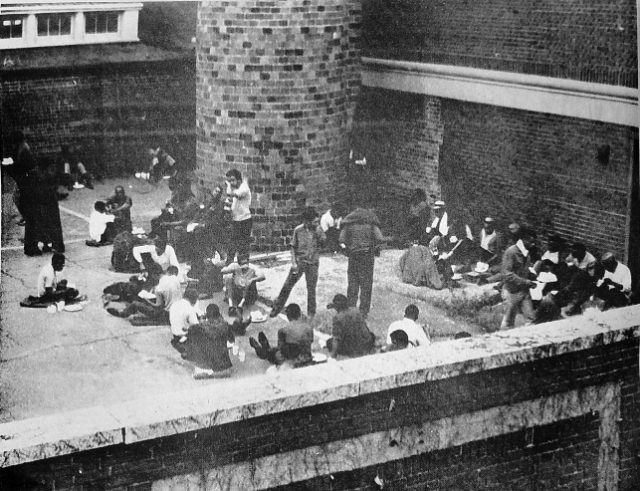
BELCATRAZ: Prisoners warehoused on Belle Isle
I woke up and they took me back to the hoosegow. I went back inside the joint. Then they put me through the same old bulls— again. So we got back on the bus and they shipped us out to Belle Isle. They treated us pretty nice out there, cause they left you alone. But it was just like a concentration camp. You had to eat, and get on single files here. You had to eat in the courtyard, rain or shine. Most of the time I was sick after that. I was sick and I slept most of the time I was there. One day I was laying down on this cot ready to go back to the hospital and have my head examined…
C: To have your head examined?
W: Yeah, see, they thought I had a concussion.
C: But they forgot about your appointments?
W: They sure did. Let me tell you something else. The first time I went to the hospital … the first time I went to the hospital, here’s what happened. Now, I was supposed to go to the hospital that Tuesday — that’s the only time, this clinic is open at Receiving Hospital. I gave my list … my little notice to the man, that I was supposed to go. And he says, all right, we’ll call you tomorrow.
OK. So I went up to remind them, you know. And he said, ah, it’s too late, you can’t go. And the next day I really got monked up, you know. And I was waiting for them to take me to the hospital that day. So I was laying down on this cot, man, I was gone — I was sick as _______. So this little National Guard — this punk — he was sitting over there cocking his gun — you know, playing with it.
And I said, I just raised up and I said, look, peckerwood m——f—–, I said, look, if you want to play that s—, you go outside and play that s— with your little toy soldiers, you know. And the man heard me and he said, who said that? And I said, I did, god— it, what you going to do about it? By this time, like I say, I just didn’t care anymore what they did to me. But that wasn’t no reason for that man over there sitting there playing with that gun like that. My nerves wasn’t no good anyway. He [They?] was shot after that.
Wayne County Jail
So they take me to the county jail because I’m going to arouse everybody. I should of. So I was taken back up to the county jail and taken up to the hospital. And here we go — they had this little old med student up there. They call them medics, see. They’re not doctors. So this cat is gonna look at my medication, you know, and he gonna give me some more and all this s—, you know. He says, you was supposed to go to the hospital yesterday, why didn’t you go? I said, them peckerwoods wouldn’t take me, man.
[He] Asked me why didn’t I go. He said, well, you can’t go now. But you be sure and go soon as you get out of here, you know. And I says OK, there, if I don’t be dead. So this old sheriff’s deputy come in, who brung me up there. And dig what they was talking about man. I thought it was really … really turned off you know. I just wanted to jump on him and shoot his god— brains out.
The guy said to him, he say, yeah man, I heard you shot four of them in the riot. How much the county paying you? The guy said, ten dollars a head. And he was giggling about it. Man, you don’t do that in front of people. See. I know all he could of shot was niggers — that’s all he could of shot. He didn’t shoot nobody else. And he sitting there giggling about it. Ten dollars a head. Is that what they do man? You mean the county is paying for shooting people? Ten dollars a head.
That’s good, I like that. But I don’t have to pay nothing for their heads — I’m going to kill them for nothing. So, the man say … he took me back down to the joint and put me in a cell and I stayed there. I can’t remember all the details — they moved us back and forth so many times and so many places, you didn’t know where in the hell you were going next.
They wasn’t telling you nothing. We stayed in this cell for a couple of days and then my court date come up. Man, when they called my name to go to court, I hopped out of there. And when I was going out I was praying to God that I was getting out of this joint.
Recorder’s Court
C: Is that the second time you’d been to court?
W: Yes, the second time. The first time you have your examination and then you have what they call a trial.
C: This was a trial?
W: Yeah, you have an examination and then you have a hearing.
C: Oh, a hearing. W: Yeah. C: What day is this? W: It was August the 8th … that was the day, August the 8th. C: That was a week after you were … two weeks after you were arrested. W: Yeah. C: Two weeks?
Free at last
W: It seemed like a hundred weeks to me. Well, I went to court and I walked into the courtroom and the man, Judge Columbus [Robert J. Colombo, Sr.], he just looked at me and he say, I suspended your case, you know. And he said, go on home. That’s all he said — he said, cause we ain’t got nothing on you. He told me to go on home.
I turned around to that man — I was like a beast let loose to the wilderness. That’s just what I was, I was an animal. On [the] outside I was yelling and screaming — I jumped down the street. I was just like a hyena, I was an animal. I looked like one too. And I felt like one. Every white face I passed I wanted to smash it. That’s just what I wanted to do. So. After I got back to the inner city I managed to hustle up a quarter from some of the people downtown I knew and I got back to the inner city.
Mix-up
C: How was it you got released? And how did you get in the mix-up?
W: OK. This psychologist friend of mine, he got a lawyer for me — his brother. You’re going to talk to him ___________________________. Lou sent his brother down there to get me out, cause I managed to get a telephone call out to Lou. Lou’s brother came down there and the man told him my name. He told two people — he told (oh man, I can’t mention the people. You don’t need to know their names do you?)
C: No, I don’t.
W: Well, he told this reverend that I was in Ingraham [Ingham] County, see. I wasn’t in no Ingraham County. I was right there in county jail. And he told the lawyer when he asked my name, he said, we got him? He said, uh uh, no, you can’t see him. He told him he didn’t know where I was. So they got pretty peeved at this and Louie’s brother told them they better leave me alone.
C: Why did he say this?
W: He said they better leave me alone because I was too hot to hold, or something. Something. That was it.
C: They thought you were someone else?
W: Yeah, they got off somebody else. They thought they had a man, so, you know. I could of got out if the lawyers could of got to me. But no lawyers could get to nobody. That was just it.
Lost, then mad
So, we went to court and the guy says he don’t know me, and they say get home, And I went. When I call home, I’m talking about your [my?] neighborhood. And when I got off that bus it hit me. I saw all this destruction. I was lost after that for a while, two weeks or three weeks or so. I was … my mind and my body was separated from one another.
And I walked around like that for a long time. I couldn’t find my family all together, so I just went back to this friend’s house and I stayed there. I slept most of the time. And I just stayed away from people. I can’t tell you — I can’t really describe it, but you were completely — the word is dehumanized. You were gone.
C: Angry?
W: I didn’t get angry. I was dead inside and I lost contact with the world. But after I came back, slowly but surely I got madder and madder. And I’m mad row. ‘I ain’t got nothing to lose’
C: How do you feel today?
W: I could knock some man’s head off. I feel like this now: if one of you should dare touch me again, try to dehumanize me again, I’d kill you. Just like that — outright kill you. And I ain’t gonna have no compunctions about it. Kill you. So.
C: Are there many people who feel like you because they were arrested?
W: We all do. We all do. Those people are talking about … you know they kept them there so long that everybody just said, we’re going to do something when we get out of here. We’ll blow up the police station, and things like that you know. These people were sick.
Personally I don’t even like to talk about it. I’ll be frank with you. I hate to talk about it. When I remember about it, I get angry. I get mean as hell, you know. That’s an ugly thing that you do to people. Then you expect them to be nice. You know, that you pat them on the back and say, be nice little n——s, and [you] say conform to our laws.
Hell no! No we can’t conform to your laws because you didn’t give us the due process of your laws. That’s what. Don’t you ask me nothing. Nothing. The only way I’m going to feel like part of this country of America is that you drop some of your requirements and let me do something. Get off my damn back. And if you don’t get off my back, I’m going to move you. I’m going to move you either by force, by destroying your cities or your country. And I’d do it in a minute. Cause I ain’t got nothing to lose.
The fire next time
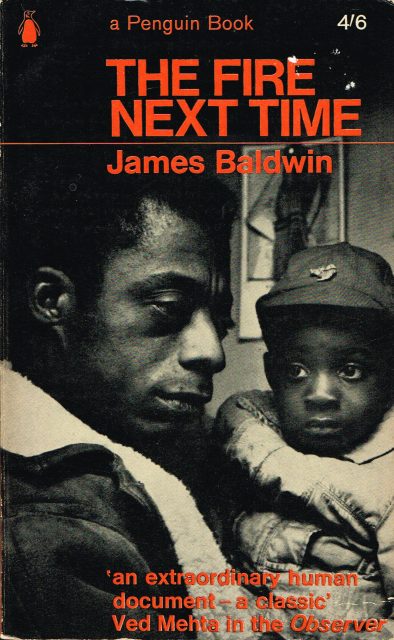 C: How does being arrested and having all this happen to you affect you?
C: How does being arrested and having all this happen to you affect you?
W: Affect me?
C: In what way are you different now from before?
W: Before I was quite passive. You know I couldn’t hurt a fly. I was really a passive person — hard-working — trying to reach this goal, trying to get that degree. That’s what I wanted. And I wasn’t messing with nobody. I didn’t break no laws or nothing — went along to [with?] people. I got too much resentment inside me, or bitterness now to let it happen again — to let somebody say to me, you have to do this.
C: Suppose there were another riot?
W: Another riot? You know, if there was another riot, you know what I think I’d do? I think I’d blow up police stations. I’d go killing this time. Oh, I’d go killing … I’d kill. That’s just what I’d do. Man, I ain’t against all white folks, man, but they don’t stand by and let that happen. Yeah, that’s what I’d do first — I’d blow up the police station and kill all the police I could. Man, I’d set more bombs and booby traps in the world. Kill them, just like that. I’d do it. Personally I hope there’s not another riot. Because this time it’s gonna go farther than it was — it’s going to spread. It’s going to cause a lot of destruction — everywhere.
C: (inaudible)
W: Only thing now is that whitey stops forcing, and I’ll stop forcing. You got to get them off that stuff man. That’s about it you know. I’m still recuperating in a way from, you know, all that stuff you know. That’s why I do the things I do you know — work with the people I do — because I’m trying to forget. Cause the minute I stop trying to be constructive, I’m destructive. And that’s not nice — destruction.
We would like to thank the LBJ Library and Museum, the Burton Historical Collection at the Detroit Public Library and The Detroit News for their kind assistance. — PL.
Copyright © 2007 by Paul Lee
Full interview of Jaramogi Abebe Agyeman, in You Tube video by Paul Lee.





During the Detroit riots of 1967, I was a member of the Coast Guard Station on Belle Isle. I was a 20-year-old Seaman. Our station had a crew of 15. Each night, the Officer in Charge and 7 crew-members went home. Seven members stayed overnight – boat coxswains, engineers, and non-rated boat seamen. The station was adjacent to the Detroit River. A chain link fence surrounded the other three sides of the station. However, there was no gate. A chain covered the gateway. A sign hung from it: “Keep out by direction of the Commandant.” Anybody could step across it or crouch under it.
On the evening of June 23, 1967, our station and the Army Nike Base a few blocks east of us were warned by telephone that a mob would besiege us for our weapons.
We ran a 40-foot patrol boat out of the slip and tied it to the sea wall behind the station. The twin engines were left running.
A large crowd gathered outside the fence. The Officer Of The Day, a First Class Petty Officer (equal to an Army Staff Sergeant), opened the armory and distributed weapons to us. In addition to bedding and basketballs, the armory had three M-1 rifles, three .45 caliber pistols, one .22 caliber pistol that looked like a .45, a double-barrel shotgun that somebody had left there, 24 bayonets (for three rifles), 12 nightsticks, and more Shore Patrol armbands than our full crew could wear. There was a box of plastic helmet liners painted white. A recruiter had stuck on decals that said, “If you have what it takes, take the Coast Guard.” As I put on my helmet, I thought the decal might send the wrong message to the crowd. I put a clip into my rifle and affixed a long chrome bayonet. I knew the Army had newer M-16 rifles with fully automatic fire.
The front door of the station faced the driveway. The back door of the station faced the sea wall. There was a small porch with three steps at the front of the station. We assembled on the steps with our plastic “come and get us” helmets and our shore patrol armbands. Three men stood on the lowest step, holding .45 caliber pistols against the side of a leg. Three men stood on the top step, holding M-1 rifles with affixed bayonets. Our First Class Boatswain’s Mate stood beside the steps, holding the shotgun and wearing the .22 caliber hand gun. Our front door was propped open. We were told, “If they cross the chain and rush us, everybody fire once, retreat down the hall to the back door, jump on the boat, and move into the river.” We were told not to fire until the First Class Boatswain’s Mate directed us to do so.
The Boatswain’s Mate used a bullhorn to shout to the crowd that they must stay out of the property, and that we had regular station personnel inside in addition to the security force outside. We did not. We seven were the regular station personnel.
After about thirty minutes of standoff, three Detroit Police tanks swept in front from the East, the direction of the Army Nike Site. They were blue steel armored vehicles with three huge rubber tires on each side. There were gun ports. The Police tank crew pushed the Nike site crowd and our crowd to the west.
The Detroit Harbormaster Police patrolled the island by car and boat. Our missing crew-members reported to the Harbormaster Police and were brought by boat to the station as they trickled in. Although we continued to see crowds of people, no one attempted to enter our station. We maintained a 24-hour armed guard. No one got liberty to go home for about 7-10 days.
I’ll ever forget the riot. My cousin was only four-years-old when she was killed. I was in the apartment with her during the killing and we both would have celebrated our birthdays on 8/4 and 8/8 (her birthday). My mother’s arm was nearly removed from the horrible gunfire. The apartment was very smokey after the shooting by National Guard and they forced everyone on the street and pointed the long rifles at us.
What a wonderful article Diane. It has so much information and history.